6 Volumes
BANKS REDEFINED
American banking was invented in Philadelphia. The banking center of America has moved away and changed in extraordinary ways but the foundations remain.
Recent Convulsions in World Finance
Few people choose to study economics; most people don't want to. But world economics have got in such a state that lots more of us had better give it some thought.
Sociology: Philadelphia and the Quaker Colonies
The early Philadelphia had many faces, its people were varied and interesting; its history turbulent and of lasting importance.
Money
New volume 2012-07-04 13:46:41 description
Second Edition, Greater Savings.
The book, Health Savings Account: Planning for Prosperity is here revised, making N-HSA a completed intermediate step. Whether to go faster to Retired Life is left undecided until it becomes clearer what reception earlier steps receive. There is a difficult transition ahead of any of these proposals. On the other hand, transition must be accomplished, so Congress may prefer more speculation about destination.
A New Era in Politics: Clinton, Obama, and Trump
New forms of communication made the party system largely obsolete.
Banking Panic 2007-2009 (1)
Mankind hasn't learned how to control sudden wealth, whether in families, third-world countries, or the richest nation in history. The world banking crisis of 2007 is the biggest example yet.
IN lifting a billion people from desperate poverty to moderate prosperity, economic globalization has been a premier good thing for the world. Globalization however made many financial stumbles in developing countries; in 2007 even America finally stumbled, badly. Few people now dispute three basic facts: huge new wealth was dumped on the globalized monetary system. Somehow this caused a housing bubble in America. And somehow this bubble toppled Wall Street. Two years after its sudden explosion, opinion about cause is divided into two main camps. One maintains a house of cards is certain to collapse; it's futile to play blame-game when it does. The other viewpoint is that responsible people know enough not to sneeze near a house of cards, so it matters who did sneeze. This article examines the two propositions, concludes that still a third theory is more likely, and propounds it. Fixing a mess this complex so it never happens again, is a project too large to succeed unless many people grasp what it was really all about. Even if they can't fix the problem, at least they can listen to the Greek physician Hippocrates: Don't make it worse.
Perhaps real estate stresses, banking stresses, and the stresses of emerging economies all relate to the same flaw in human character, the difficulty adjusting to sudden great wealth. The goal here, however, is not philosophical elegance, but to get out of an economic mess, at a minimum not worsening or repeating it. The world monetary order may well be at the root of the problem, but world monetary order can wait until more tangible things are fixed. So, in this article it comes last, except for this initial declaration: A wealthier world made America richer, too, and we shamefacedly admit we couldn't handle it.
Hovering in the background, moreover, the computer information revolution made everything move faster, surprises come sooner; problems quickly grew huge before being recognized. Over a hundred other national banking crises have erupted in the past thirty years of the computer era, mostly confined to small poor countries with scant experience. World history shows sudden new wealth, while welcome, violently disturbs the existing order. It is little different whether new wealth comes from gold rushes or striking oil, from inventions, or new forms of securities trading. Previous wealth and experience help steady the balance, but to think one is immune to the nouveau riche weakness only means one has not tasted large enough doses of it.
August, 2007: Sudden Financial Jolt
 For the moment, the broadly unanticipated behavior of world bond markets remains a conundrum. 
|
| Alan Greenspan, Feb.16, 2005 |
In early August, 2007 the stock market was sailing along nicely. A great many people were on vacation. September is traditionally the month for severe market reversals, but this year in early August there was not much sign of an impending jolt. The stock market's Dow Jones Industrial Average had reached an all-time peak over 14,000. Long term interest rates were abnormally low, it is true, but that anomaly had gone on uneventfully for years; anyway, even Alan Greenspan said he didn't understand it. Suddenly, the Dow Jones Industrial Average dropped 400 points in ten minutes, on heavy volume. It takes a big volume of sales to move the market that much, that quickly. Somebody knows something, but I don't know what it is, was the thought at ten thousand trading desks watching computer screens, worldwide. A quick check with networked friends showed that nobody else seemed to know what was stirring things up, either. In retrospect, we still don't know who did the first heavy selling, but it soon spread to hedge funds. Hedge funds have a lot of money, and vast banks of computers to do their selling. When the computers of heavy traders detect sudden selling volume, they are programmed to sell, too. Don't ask questions; somebody must know something, so get out, get out the door without a backward look. Not only was someone selling big, but probably selling short. The commentators on cable TV started jumping up and down, talking all at once.
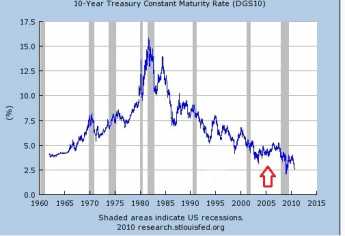
|
| Graph: Prices of 10-yr Bonds |
About a day later, someone made a shrewd guess. The problem seemed to center on those low-interest rates for long-term bonds because those low rates were abruptly going higher. In the language of the market, the "spread" between short-term and long term rates was widening or at least returning to normal. Not knowing why the spread had narrowed, no one knew why it had stopped being narrow; but it was nevertheless a clue where the problem might be centered. About a month later, rising interest rates seemed even more central when clues to many other suggested culprits had proved false. The selling concentrated on blue-chip stocks, but there was nothing the matter with blue chips. They had been sold because other markets were frozen with fear; if someone needed cash, there was nothing else the market would buy. The "quants", the traders who programmed computers to react without thinking, had merely reacted in sports jargon, to a 'head fake' in the blue chips. Meanwhile, interest rates continued to spread apart; someone big was selling a lot of long-term bonds, and was really serious about it.

|
| Alan Greenspan |
Come to think of it, if long-term interest rates were returning to normal because someone was selling bonds, then, of course, they had been too low for years because someone else was buying too many bonds. Maybe the Middle East oil barons had a hand in it, but more likely it was the Chinese government, who were known to hold a trillion dollars of U.S. Treasury bonds. Some years ago, Chairman Alan Greenspan of the Federal Reserve worried out loud that by historical standards, public markets [in this case, the Chinese government] were agreeing to accept interest rates for long term debt that seemed much too low for the risks undertaken in loaning it. Worse still, the reasons were unclear. Greenspan called it -- a conundrum. Home mortgages are long term debt, and here's maybe another clue. For political reasons, tax laws had effectively made mortgages the cheapest way to borrow. For another, the reverse mortgage, or home equity loan innovation, transformed home mortgages into the equivalent of ATM machines. A great many young people who might have been better off renting a place to live were persuaded that owning a house was essential to improving 18% credit card interest into 6% mortgages, and tax-sheltered 6% at that. Hidden in this borrowing revolution was the unrecognized temptation to maintain far less owner investment in the house that had been true in the past. It became cheaper to borrow, riskier to loan. American homebuyers were subsidized to borrow, and for whatever reason, Chinese were inclined to lend.
If interest rates go up, the value of bonds with low coupons goes down. Plenty of non-Chinese owned bonds, mainly American banks, and insurance companies. If these bonds had been purchased as long-term investments, there was no sense in selling them, and it was merely annoying that stock market prices for bank and insurance stocks dropped to reflect this lessened value of their holdings. If the banks and insurance companies merely held the bonds to maturity as they had always planned to do, bond values would return to their original price. True, there were rumors that bonds related to California and Florida real estate were in an unsound bubble. But if every one of those bonds became worthless, which was unlikely, it would only amount to $100 billion in losses. That's, of course, a lot of money, but easily absorbed by a big economy. Many of those bonds were insured, and at least half of real estate value is usually recovered in mortgage foreclosure. A lot of people would be inconvenienced by markets frozen with fear, and panic selling of various sorts would make the markets volatile. But this was mainly a liquidity crisis, roughly equivalent to a man with a $20 bill who was temporarily unable to get a candy bar out of a dispensing machine.
Supported by such talk, the stock market went down moderately but steadily. After a year, it was down two thousand points, or perhaps 15%. We seemed likely to have a recession, but periodic recessions are a healthy way to correct irrational exuberance. Most Americans do not own Florida and California real estate, don't use the banks and insurance companies in those regions, and have a reserved opinion about those who do. Somehow, it was overlooked that the very first banks to collapse in this upheaval had been in Germany, France and England.
In retrospect, in 2011 we
What's a Collateralized Debt Obligation (CDO)?
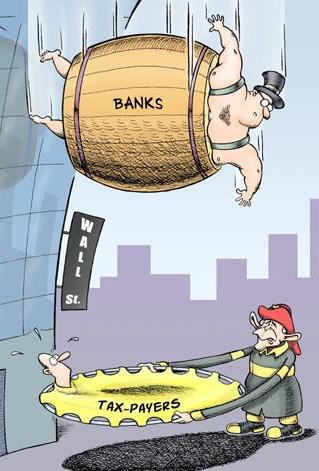
|
| CDO |
Securitized debt obligation (SDO) might be a better term than a collateralized debt obligation (CDO), but it never caught on, so the unwary easily confuse CDO with CDS, an entirely different derivative called a credit default swap. There will be a lot to say about credit-default swaps in the present financial muddle, but for now, we focus on the process of securitization. A CDO accomplishes the transformation of debts into securities, usually by aggregating a large number of similar debts (mortgages, construction loans, college tuition loans, etc) into an issue of bonds or stocks. In so doing, it goes from banking to finance. A bank deals with depositors, and it also deals with borrowers; its function is that of an intermediary between the people who have spare cash and other people who need to borrow it. Finance is one step removed from banking; the people who lend and those who borrow are often dealing with different institutions, who deal with each other or through an exchange. When the securitization process is complete, the lenders and the borrowers only begin the process at each end and most of the transactions end up in the hands of investors far removed from the original loan.
Although with more middle-men there are more fees to middle-men, securitization in the financial market's deals in large volumes and ordinarily introduces some important cost efficiencies. Instead of the expensive process of many bank branches painfully assembling a myriad of deposits in order to assemble enough to lend out a mortgage, much larger lumps can be assembled in Wall Street capital markets with little more than a phone call. It is possible to borrow wholesale from Wall Street, avoiding the expensive situation of sometimes having more money to lend than requests for loans, while someone else has more loans than cash to lend. Furthermore, the expensive risk of "borrowing short and lending long", that eternal nightmare of banks, is blunted. And the source of funds available for lending can become national, or international, rather than limited by the savings of local community surrounding the bank. Surpluses can be matched to loan requirements, another efficiency.
Unfortunately, the resulting creative destruction of bank branches creates one major offsetting disadvantage. The days are mostly long gone when bank managers would drive around and check whether mortgaged houses were painted and roofs kept in repair, but banks still usually have a better idea of the reputation and appearance of their customers than anyone in faraway Wall Street would ever have. Some method of risk assessment would have to be devised to replace the bank's eye on the client. It was devised, it was clever, and it was cheap. Unfortunately, its adequacy for the job is now in question as the CDO market chokes up. If it manages to survive this present test, it will surely replace the expensive old system and traditional banks will have a pretty hard time competing with it. Indeed, if things work out, the present colossal mess will be shrugged off as a good idea temporarily overwhelmed by its own success.
And if things don't work out, we certainly have a problem. The outcome revolves around figuring out some way to measure the risks and segregate them remotely by computer, thus replacing the local bank manager, whose job is to avoid the risks by looking at them one by one. Since at this point in the story we know in advance it didn't work, the flaw in the securitization of mortgages lies right here.
Securitization
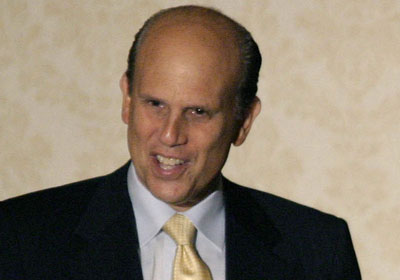
|
| Michael Millken |
It is not fanciful to link the credit crunch of 2007 with the savings and loan problems two decades earlier. Both bubbles were related to home mortgage financing, and the first bubble turned destructive by seeking money to keep itself going. If dammed-up surpluses of the Middle East and China could be made available to American mortgage lenders, there seemed to be ample demand for them. Furthermore, while Michael Millken is mostly known for his prison sentence, he had nevertheless made an important observation. Risky mortgages were generally overpriced. That is, the aggregate extra cost of subprime defaults was appreciably less than the aggregate extra interest being charged for them. If some way could be found to make the risk premium more appropriate to the actual risk, home mortgages would get permanently cheaper, and mortgaging profits would likely be gratifying. Mortgages needed a better system for establishing appropriate interest rates, and they needed more of that underemployed wealth of the Orient. Derivatives suggested themselves as a solution for both issues.

|
| Chairman Alan Greenspan |
The unaccustomed wealth of Asia and the Persian Gulf was put under heavy pressure to migrate to America by lack of local investment opportunities but was bottled up by rudimentary banking systems in the developing world. As ways were found to get around obstacles for exporting this money, the danger increased of "asset bubbles" inflating whatever they touched, for example, the dot.com stocks in 2001. The pressure indeed needed to be deflated, but carefully. Furthermore, certain accords reached in Basle around 1982 made it even easier for banks to issue loans, while the favored tax treatment of interest from residential real estate loans directed lending to home mortgages. Indeed, the calculated cost comparison between buying a home or renting it had once remained identical for fifty years but began to diverge in 1982. By 2007, it was significantly more expensive to buy than to rent, even though many analyses suggested a housing surplus existed, particularly in California and the Southwest. While the interest-rate premise was correct, the earlier campaign against "redlining" probably did encourage loans to people who could not afford the house, and there was momentum to this idea. But the most obvious stimulus to continued high-priced home purchasing, in the face of a growing over-supply, was the momentum of abundant cheap money. To mop up a growing housing surplus, initially low "teaser" interest rates were offered for ARMs, or adjustable rate mortgages which could abruptly adjust upward after a few years. A growing problem was being set up to go over a cliff. Chairman Alan Greenspan fretted at his seat on the Federal Reserve Board that it was difficult -- a conundrum -- why market interest rates for long term borrowing did not rise enough to put a stop to this. In retrospect, it seems likely the risk premium had long been too high and was now reaching for more appropriate levels. Derivatives were the main instrument for bringing rates down, and they did it with breathtaking speed, perhaps overshooting in the process. As is often the case with innovation, the risk of failure was overemphasized, while the dangers of success received little attention.
Credit derivatives can also be viewed as a form of insurance, protecting the lender if the borrower defaults. That doesn't sound like a bad thing. True, all insurance creates a "moral hazard" that encourages risky behavior by reducing its pain. No one, it is said, washes a rental car. But in a housing surplus, the insurance protection allows banks to take more chances in marginal situations, using up the surplus. Young folk is allowed to get started in life; the poor are allowed to enjoy the American dream. Unfortunately, some will abuse the privilege by buying speculative houses in a rising market, and "flip" them. Many will buy bigger houses than their income can support. Some, who should more wisely rent because their employment prospects are not secure, will be tempted to buy. All of these considerations are wrapped up in the interest rate the lender charges, so eventually, interest rates will rise to a level that anticipates -- discounts -- them. Interest rates did not rise. The old levels of risk "premium" did not reappear.
It seems now that increased demand stimulated by derivatives was not resisted by a shrinking supply of money, with a balance maintained by the adjustment in interest prices. Indeed, a good even brilliant idea was crippled by a series of responses to the puzzling environment. Banks learned to sell pretty much any mortgage as quickly as it was created; after that, the extra risks were none of their concern. It has been suggested that banks be required to retain a portion of any loan they originate but to do so would exhaust the bank's lending capacity during a bonanza of business. Standards for a bank's lending capacity are set by the Federal Reserve, as a multiple of their retained profits or reserves. Those capacity limits had been relaxed by the Basle accords, but only on condition, the banks restricted themselves to AAA-rated loans. This will turn out to be a critical point because it put unwarranted reliance on the opinion of the rating agencies, and in any event, led to "tranches".
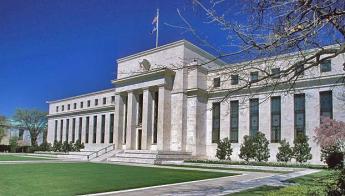
|
| Federal Reserve Building |
Here's how things roughly went. Investment banks learned to buy up and combine great bunches of these mortgages into a bundle. The bundle was then sliced into tranches of lesser bundles, attempting to sort out the bundles by their credit rating. Elegant mathematical formulas were brought forward which did a fairly good job of sifting the potentially weak loans away from another bundle that was largely risk-free. Those better sub-bundles, thought to warrant a AAA rating, were then sold to institutions who were restricted to them by the Basle accords but paid a lower interest return than the mortgage pool they came from. That was already an uncomfortably low rate by historical standards, now made lower. However, in view of its superior quality with default risk removed, it could be bought with borrowed money, eventually creating an adequate but leveraged return after costs. The debt was thus piled on debt, and the process repeated with exaggeration on the next lower quality tranche, the AA paper. And so on down to the lowest grade, which was thought to contain all or almost all of the default risk in the whole mortgage pool. People who bought the lowest tranche were real risk takers, experts who knew what they were doing, receiving a premium interest return to do it. Because this process was thought to create a sophisticated assessment of the true risk in the bundle, it was thought it would justify lower rates for everybody, squeezing out the unnecessary cushion of comfort. It was a plausible idea, and if it worked, it would be a brilliant one. But it had a big unrecognized flaw. It assumed that essentially all of the defaults would occur at the bottom of the pile, or possibly at the next higher level. There would be no defaults in the AAA level until all of the lower tranches had been wiped out -- an almost inconceivable economic calamity.
Ingenuity was then carried to yet another level. Credit derivatives are a form of insurance against default, but there was a more traditional form already in existence. Several so-called monoline companies offer insurance against default, backed by the enormous strength of pooled resources of a number of the largest strongest financial institutions in the world. The rating agencies assess their strength as AAA, the highest quality. Now, it was reasoned, if a tranche of mortgages rated AA by the agencies were insured by an insurance company, itself rated AAA, then the effective risk to the investor was really only AAA, or negligible. Alchemy. The lead was turned into gold. Unfortunately, when the panic finally hit, monoline insurance stock which was considered rock-solid at $80 a share, was soon selling for $15. The flaw in all this was that the rating of the bond was based on the credit rating of the borrowers. No one had supposed that people who were quite able to pay their debts would walk away from them. When home prices fell only ten or so percent, many of them fell below the cost of the borrowed-up mortgage. Instead of feeling horror at defiling their credit reputation, many of these prosperous borrowers regarded foreclosure as simply a business decision. The protection of monoline default insurance was trivialized when one of the smartest investors in the world, Warren Buffett, announced he proposed to form a company to ensure municipal bonds, and only municipal bonds, against default. Since that might strip away what had become the only profitable portion of the monoline portfolio, the prospect of such crippled companies paying housing claims would be bleak. Pseudo AAA tranches were now clearly back to being AA, and even real AAA tranches were under a cloud. All of this was not anticipated.
There remain two other questionable developments in this colorful adventure: the role of the rating agencies, and off-the-books behavior by the regulated mortgage originators.
The Housing Bubble

|
| Alexander Hamilton |
Since ups and downs of the American economy have relentlessly followed each other since the time of Alexander Hamilton, it's unfair to blame the President who happened to be in office when each bump began; but we do it anyway. Two bubbles began during the presidency of George W. Bush, the dot-com surge then the collapse of 2001, and the housing bubble which rose from the ashes of that collapse, crashing in turn in the summer of 2007. Both episodes can be viewed as responses to the world money surplus which grew out of globalization, which itself can be viewed as growing out of the computer revolution which started around 1975. Maybe that's wrong, but it's common to believe it is right. The world economy is an over-inflated tire, so bubbles appeared at weak spots. When money fled the stock market of electronics stocks, it moved to American real estate, facing us with the choice of another bubble to follow this one unless the collapse of this bigger bubble deflates so badly we have to whimper through a depression for a couple of decades.
This grand preamble is intended to answer whether a housing surplus caused the bubble, or a money surplus did. Economists at the Federal Reserve, charged with examining such questions, are firm of the view that money surplus came first, causing too many houses to be built. The money surplus, in their view, grew out of the tendency of people (in this case, Chinese) to get prosperous before they learn how to spend their new wealth, so they save it. Without further debate, we will assume excessive savings in developing countries tended to swamp the world financial markets, and if it hadn't been this bubble it would have been some other. We went 18 years without a major recession and would have to go another two decades -- forty years, in all -- for things to work themselves out calmly. It's a pity, but that's the price of being too successful.
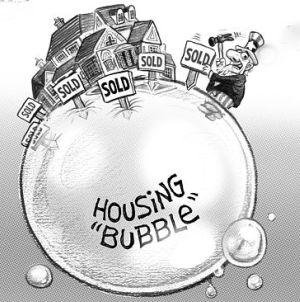
|
| Housing Bubble |
A briefer capsule of the housing bubble would describe how surplus funds in the banking system made it cheaper to lend out mortgage money, which soon led to surplus houses, which caused the prices of houses first to go up and then to go down, soon followed by the banking system, and maybe through banks to the rest of the economy. Stock speculation is easier to manage because houses take a very long time to disappear once you build them. Judging by the experience of the 1929 crash, it takes nearly twenty years for confidence to return after a bad crash, so perhaps the loss of confidence takes longer to recover than real estate prices. In fact, Europe looks as though it may take a century to recover its nerve, and by that time Europeans could be permanently in the dustbin of history. It can all be an unpleasant set of reflections.
Frozen Markets
 Markets cannot clear without transparency. 
|
| Vikram Pandit |
Lots of people, perhaps far too many, borrow money. Many fewer are involved in the institutional lending of money, although still quite a few; but only a handful of those few have much familiarity with the mechanics of bank panic. Meanwhile, terms of art get propelled through the news media, accepted as established fact by almost everyone but placed in a peculiar storage category. Almost everyone knew the markets froze up all over the world; almost no one could define what was meant by that.
It meant that it was suddenly impossible to buy or sell financial instruments which normally are bought and sold by the thousands every hour. Some things were more thoroughly refrigerated than others, suggesting they were possibly at the heart of the problem, and some things took longer to thaw than others. One's grandparents could relate times in the 1930s when local towns had to pay their policemen and school teachers with a script because they could not obtain currency. So frozen markets could become serious, not just a day off from school. Basketball games and election campaigns continued to dominate the news, but deep within the newspapers markets continued frigid for quite a while, ominous and mysterious ice caverns.

|
| Abby Hoffman |
Many factors contributed as causes, and perhaps the greatest causes have not even been identified a year later, but two phenomena seem to explain a lot. The first was widespread reluctance to accept current market prices as realistic because no one likes to believe money is forever lost. The validity of market-based prices carries the assumption that weight of opinion will push prices in one direction or the other; if prices go too far, opportunists will push them back. Markets don't set prices, they "discover" prices by finding the price which temporarily balances the opinions of the universe of buyers and sellers. If you were Zeus, you might chortle at how wrong they all were, but nevertheless, the consensus "discovers" the price that clears the market. What Zeus thinks has nothing to do with it. The process of orderly matching of bids can come briefly to a halt for any number of silly reasons; Abby Hoffman once paralyzed the trading floor of the New York Stock Exchange by throwing dollar bills over the rail of the visitors' gallery, with a single hundred-dollar bill hidden among a lot of singles. Ramming an airplane into the building will do it longer, even for a while after the unexpected event is understood. But a lasting freeze-up is more likely to occur when the trading process unexpectedly drives all prices up or down, giving a signal that no longer is opinion equally divided, everybody is in total agreement that prices are going in a single direction, and no one, therefore, knows how high or low they are going to go. If everybody wants to sell, no one will buy.
Ordinarily, only a tiny sample of stocks or bonds are involved in daily trading, establishing a signal for what the rest --locked in banks or safe deposit vaults -- are worth. Most important are the inert securities "caught in a loan", being held as security for a loan on the presumption they are worth somewhat more than the loan. If the market abruptly decrees they are worth less than the loan, the bank will call for extra collateral, and failing that, will sell the collateral. When there are sudden runs in one direction or another, it becomes impossible to say what the collateral is worth; it's a good time to get out of the lending business if you can. Because no one dares buy, no one is able to sell; if you can't tell what the collateral is worth, no one will lend. That's pretty much what a frozen market looks like.
A variation of this concept arises when a banker refuses to sell because the emergency sale at a distressed price will "publish" a false price, which will then be applied to all of the rest of the bank's holdings, suggesting that those immense piles of securities in the vaults are really worthless. When distressed prices do surface, major banking concerns will refuse to acknowledge them as true prices. Because refusing to honor the "going price" is very disruptive, regulators force institutions to "mark to market" every day at the end of the day. If marking to market amounts to an admission of insolvency, that's unfortunate. A brokerage house forced into receivership because of obviously fallacious pricing can be even more bitter when it is recognized that commercial banks are not forced to mark to market, even with exactly the same securities. Banks are permitted to declare that securities are a long-term investment, marked on their books at the purchase price rather than the market price. Such maneuvering however gradually forces the bank out of the lending business at the same time that truly worthless paper is allowed to masquerade as sound securities. In the long run, it's bad for the economy, and in the long run, the bank goes out of business anyway, it just takes a few months longer. While this process is underway, the regulators will force weakened banks to issue more stock, thus diluting the value of the existing owners, a sort of punishment for improper management. Under the circumstances, a major incentive is created to avoid letting the world know how you stand. Transparency, as they say, suffers.
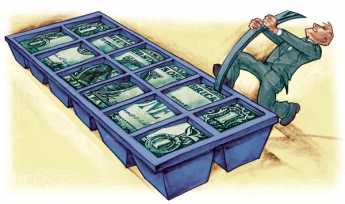
|
| Frozen Markets |
Repetitive Trading.In recent weeks, a professor at the Wharton School made a name for himself with theory with the power to become a law of the market place because of its power to explain some quirks. Repetitive trading in the financial marketplaces differs significantly from the market for used cars, say. If a single trade takes place for a high-priced item, the buyer and seller concentrate their efforts on getting that one price as favorable as they can; usually, the seller has superior information and more practice, so he sells for a profit margin over the real market price. Most customers hate this flea market. On the other hand, when two brokers make ten or twenty trades a day for months on end, they become valuable clients to each other. The value of sustaining the relationship is greater than the occasional opportunity to pull a fast one, so it becomes a fact of life that an imbalance in one direction will be compensated by a collusive imbalance in the other direction in some subsequent trade. Although an occasional customer may get a poor execution from his broker, the market as a whole is smoothed out and volatility is probably reduced. There's less stress and strain on the brokers in the middle of the trading profession, until one-day things go bang. Suddenly the value of the relationship seems quite minor compared with the potential for betting wrong in a congested market, that is, a stampede. So, such traders withdraw from the market as much as they can.
O'Neill's Parable Perhaps he oversimplified matters, but the 72nd Secretary of the Treasury of the United States certainly made a clear point about frozen markets. "Suppose," he said, "You imagine ten bottles of crystal-clear drinking water."
"Next, suppose someone suddenly announces the news that one of those bottles contains deadly poison. Nobody will buy a single one of those bottles, even though there is only a 10% chance that any one of them has poison. That's a frozen market."
What's a Derivative?
The intention of the next few sections is to sort out some of the confusing components of the credit crunch of 2007, in which novel financial instruments called derivatives played a central part. Before we get into that, let's try to answer the question just posed: why did the monetary authorities respond to a surplus of cheap credit by apparently making it worse, flooding the economy with still more cheap credit? The sudden return to normal interest levels, it would appear, posed a threat of recession so severe it seemed necessary to make inflation worse in order to combat the impending deflation. The Federal Reserve may, of course, be planning only a brief inflationary move, or a sharp inflationary move soon followed by a sharp deflationary reversal. Its purpose appears to be, to prevent an impending wave of mortgage foreclosures by holding interest rates down, disregarding the abnormally low long-term interest spreads which had recently seemed such a problem. Whatever it's tactical purposes, such bewildering reversals are a signal the Federal Reserve regards the present situation as dangerous. Some degree of inflation, possibly a large one, is going to be created but the Fed seems to think it has no choice. Before getting to that dilemma, let's sort out some of the ingredients of the credit crunch that seems to have triggered this mess.
A derivative is really pretty clever. It sorts out and monetizes any or all of the risks of a business. It frees up capital by putting a price on risks, just as insurance does, without requiring ownership of the whole company or industry. Flexibility is created, and in the case of real estate loans, surplus cash in one region can be redeployed in another region where the money is tight. Flexibility allows for an increased velocity of transactions, and increased velocity of turnover is equivalent to having more money to work with. It was not so long ago that mortgages were obtained from the local building and loan, and thus were constrained by the savings deposits of the local community. Far Eastern and Arab savings are now no longer held captive by primitive local banking systems.
There are worries about derivatives, however. For all their advantages, derivatives remain strange and mysterious, and thus, always a potential target for populist politicians. They are also a zero-sum game, which means that for everyone who makes money there must be someone else who loses exactly the same amount. That's, of course, true of debt in general; it's true of loans, and of bonds, but derivatives are new. Finally, derivatives were a quick success, which makes them dangerous competitors in the creative destruction game. It even makes them annoying to non-competitors, who get trampled by stampedes.
In the particular version of derivatives of concern in real estate, derivatives stripped away the risk that borrowers would default on their payments. That made mortgages available to more marginal borrowers, adding only a small cost for the insurance provided. It allowed more accurate, hence lower, pricing of mortgages by assessing the rate of default in a whole region rather than house by house. The theory was good and the savings to everyone were considerable. But success became a problem. No longer inhibited by a shortage of capital, mortgages and home ownership were greatly promoted. Unfortunately, the demand for mortgages in America had been artificially stimulated by implicit government protection against foreclosure, by government sponsored mortgage agencies with implicit government backup, and by the tax deductibility of mortgage interest which was denied to other forms of household borrowing. If a loan was needed, some way was sure to be devised to make it a mortgage loan.
What is an NRSRO?
Congress created the concept of a "Nationally Recognized Statistical Rating Organization" in 1976. As an aftermath of the Sarbanes Oxley movement, in 2005 credit derivatives were also required to be rated by the Credit Rating Agency Reform Act. A government stamp of approval was thus placed on a handful of rating agencies, and some argue it would be better to increase competition rather than constrain it by an approval process. Others are fearful of political influence. The rating agencies themselves have expressed concern that efforts to increase transparency will impair confidentiality, and point out the existing system has seemed to work well for a century.

|
| Atom Bomb |
Nevertheless, defaults and paralysis of the credit system did occur, made worse by over-reliance on NRSRO ratings . Very likely, increased experience with this new debt security market will lead to a more accurate correspondence between predicted default rates and actual ones. No doubt, bond underwriters will make greater effort to stratify risk within the tranches with their own resources, using the opinion of independent rating agencies more as a check. Meanwhile, there may be a need to modify prevailing approaches. When evaluating a simple bond issue for a municipality or a corporation, only the financial strength of that entity is important. With the tranching approach, however, it is possible that risk estimation within each individual tranche might be perfect, but somehow be undermined by misjudgment of risk premiums to be assigned to each tranche. When risk premiums are generally compressed, there may not be enough to go around to all of the tranches.
There are seven firms currently registered as NRSROs: * A.M. Best Company, Inc. * DBRS Ltd. * Fitch, Inc. * Japan Credit Rating Agency, Ltd. * Moody's Investors Service, Inc. * Rating and Investment Information, Inc. * Standard & Poor's Ratings Services
Debt Rating Agencies
Three years ago, a gathering of bank executives were asked if they had an understanding of derivatives; it became instantly clear they hadn't the foggiest. More recently than that, Robert Rubin no less, admitted he first heard the term, credit derivative, a year earlier. When such an innovation means thirty or more $trillions quickly, it creates opportunities for quick learners. Everybody else relies on experts. But even if you grasp the credit derivative idea quickly, its innate complexity defeats you. Thousands of loans are jumbled together, shaken, diced and sliced, sold, and reassembled in new packages. The choice was clear: a banker must either decide to stay clear of such mysteries no matter how profitable they seem or else rely on the opinion of triple-A rated agencies of long and honorable standing. A great many people decided to go with agency opinion, combined with a determination to sell these things as fast as they got them. The agencies did their best with an almost impossible task, and the sales volume soared.

|
| bottleneck of computer |
In a computer age, such complexity can be quickly defined, traced from start to finish, evaluated in mass quantity, bringing final pricing decisions down to manageable form. But the bottleneck of computer programming limits the ability to address this rush job as quickly as its terms and direction are shifting. When computers catch up, much of this problem will come under control, without time-outs, new rules, or perplexing restraints. Meanwhile, the response emerged: keep as little inventory as you possibly can and meanwhile take a chance on the agency opinion. No doubt, other options were considered: play your cards close to your vest, position yourself to jump clear of trouble as soon as you hear of it. Billions, simply billions of dollars were to be made if you were quick and bold.
* * * * *
Naturally, this pretty crude approach becomes steadily safer as experience showed its strengths and flaws; in time it might even be replaced by an auction between counterparties, creating a market for price discovery. Or perhaps packaging firms would strengthen their own evaluations to a point where each firm's reputation could compete with the rating agencies in risk assessment. Nevertheless, the lack of feedback was crippling until computer programming caught up. Market participants demand reasonable correspondence between ratings and subsequent default rates. In the meantime, everyone flew by the seat of his pants. Unfortunately, in that meantime, everything blew up.
* * * * *

|
| Gaussian, or |
Mathematics contribute some insight into why it happened so soon. The Law of Averages forces a huge number of random opinions to assume a Gaussian, or "normal", distribution curve of rather narrow fluctuations. When opinions are constrained to a handful of rating agencies, however, volatility spread gets much wider, or "fractal". In the wry shorthand of market traders, a hundred-year probability then seems to occur every four or five years. Paradoxically, wide unexpected jolts are not caused by an increasing number of opinions, but the reverse. In investing circles it is said that the higher it goes, the more volatile it gets, and more likely to crash. "Chartist" observers notice this phenomenon in reverse; a period of declining volatility is known as a "pennant formation", often observed to precede a sudden reversal in market direction. Whether preceded by megaphones or pennants, when someone cries "Fire!" in a crowded theater, public opinions narrow down to only one -- get out the door.
What's a Mezzanine Loan?
 It seems like kicks just keep getting harder to find... 
|
| Paul Revere and the Raiders |
A French word for a balcony, mezzanine is derived from Italian and Latin. In architecture it describes an indoor balcony floor or elevator stop, using up spare space below the high ceiling but above the ground floor of a bank or department store. Evoking this familiar image, mezzanine has become a word to describe things which get shoe-horned into the vertical space between two other things, often as an afterthought.
In the mortgage world, the meaning you want to be careful about is a loan sandwiched between the owner's equity and the first mortgage, potentially leaving it unclear whether the "mezz" is equity or mortgage, but in fact often a warning the property buyer had to borrow to make his down payment. Persuasion efforts at the time of investor re-purchase of a mezzanine loan are apt to focus on the rich double-digit income which would result from everything going well with the loan, falling back on a cheap acquisition price for the real estate in case of a foreclosure. However, mezzanine loans are a comparatively new product, and the full range of consequences are not common knowledge. In the first place, the 2008 wave of foreclosures was not anticipated, so the risk of rich double-digit interest payments was badly underpriced. Even more important, the mezzanine loan seems somehow senior to the first mortgage, but that is meaningful only if the amount recovered from the foreclosure significantly covers the residual of the first mortgage. Even if the total acquisition cost after the foreclosure is a bargain, the big problem in 2009 has proven to be the freezing up of the financial system, with the effect that no one can be certain what the final house value will be, and consequently what the value of the mezzanine loan should be. The resulting bad name that mezzanine financing acquired in this uproar has further frozen the market with fear.
There are other definitions of a mezzanine loan in use, so the first message to investors is to make certain what meaning the term intends in a particular case. If the interest rate was underpriced, the principle of the loan was overpriced. The market will only clear when all parties reach an agreement about the degree of overpricing of the asset, the degree to which the foreclosure recovery fails to cover the first mortgage, and the risk premium needed to cover the uncertainties. Mortgage professionals will eventually puzzle all this out, but until then the existing mezzanine loans will be yet another major obstacle to the recovery of the impaired financial system.
It may or may not be helpful to understand another way of describing this puzzle. A mezzanine mortgage describes a second mortgage (by implication, a first mortgage must pre-exist), in which the security for the loan is not the structure being mortgaged, but the ownership shares of the structure held by those who pledge to repay the mezzanine mortgage. Thus, both the first mortgage and this second one can foreclose and receive nominal full value independently, rather than standing in sequence with each other to receive the same pledged asset. In this somewhat legalistic view, the mezzanine is not senior to the first mortgage, but independent of it, holding the owner's equity as security rather than the house. The legal process of foreclosure is facilitated, even though the recovery may not differ much.
In recent years, however, the term has also been used to describe a second round of tranches in a securitized pool of mortgages. This is the view that emerges from trying to price a layer in the middle by disregarding the bottom of the heap which is hopelessly lost, as well as the top of the heap which is safe and sound. After first slicing away the best grade of mortgages, the residual middle-grade bundle still contains differing levels of risk, and the top grade of a second sorting process can be skimmed off as enough better than the rest to qualify as value overlooked. When this salvaged subgroup is then insured by a ("monoline") insurance company which itself has a AAA rating, it can be claimed the salvaged bundle has effectively upgraded from, say, AA to AAA. Obviously, the validity of this financial alchemy depends on accurately down-grading the dross left behind. The most important misjudgment in this mezzanine process, however, was the unexpected undermining of market opinion about the insurance companies standing behind it. Many of them retained a AAA rating, while their stock lost 75% or more of its market value.
Language moves fast on Wall Street, particularly when a new concept needs to be packaged in a sales environment. Within a few months, mezzanine financing in common parlance quickly came to mean Alt-A. And Alt-A came to be defined as a mortgage or a package of mortgages in which the borrower was neither asked his income nor asked to prove it if the matter was challenged. That may not be exactly accurate when referring to any particular security, or package of securitized debt. But in common parlance, Alt-A was the term used when someone described mortgages where the lender knew very little about the borrower.
Having a general sense of the uncertainties, the general reader may perceive why this issue freezes up the market, and someday may be ornamental to explaining it all to one's grandchildren. But that's about all; most people become glassy-eyed, and start to run away.
REFERENCES
| Paul Revere & The World He Lived In | Amazon |
REFERENCES
| Paul Revere & The World He Lived In | Amazon |
Inverted Yield Curve: The Depositors' Viewpoint
 Much has been made of risks for giant creditors in the 2007 credit crunch. What about the little creditors, the depositors with their savings at stake? 
|
An old friend, than over ninety years old, once growled that Paul Volcker, the esteemed even heroic Chairman of the Federal Reserve, was only interested in saving "the banks". It's certainly true that many members of that board are elected by banks in the different regions, but it isn't easy to see how the Chairman could help banks if he wanted to, or why he would want to. It takes only a moment of reflection to realize, however, that all banks would naturally want to charge the highest possible interest for their loans and pay the lowest possible interest to depositors. Essentially, everybody is their adversary.
Except the Federal Reserve, which needs its regulatory power over banks to control the amount of money in circulation, in order to stabilize the currency both at home and abroad. In another place, we discuss the remarkable ingenuity and the worrisome weaknesses of this arrangement, but for now, let it suffice that it's the arrangement we have.
The difference between the prevailing return on deposits and the return on loans is called the yield curve, because short term rates, which the Federal Reserve controls, normally slope upward toward higher long term rates, which the Federal Reserve does not control. Essentially, the Fed controls what depositors are paid, but has no direct control over what borrowers are charged. Depositors are savers, and it is widely agreed that Americans do not save enough. To some degree, that must be the fault of the Federal Reserve. And when market conditions force a decline in the rates charged borrowers, the Federal Reserve must allow the banks to squeeze the depositors' rate of return, or banks will go bust. That's all my old friend was trying to say when he criticized a national hero. Luckily for Volcker's reputational legacy, he needed to boost interest rates dramatically in order to stop inflation, and that put plenty of interest in the pockets of old folks with money in bank deposits, while unfortunately, it throttled borrowers unable to obtain loans except at very high prices. He stopped inflation in its tracks, but at the price of hurting business.
For over a year before the 2007 credit crunch, short-term rates (and depositors' interest return) were higher than long term rates (and borrowers' interest cost), an infrequent occurrence called an inverted yield curve. The difference between the Bernanke problem and the Volcker problem was that this time long rates were stuck at historically low levels, probably because of international situations. Depositors were protected and banks were made to suffer, although their reserves were invisibly eroding. One has to suspect the housing bubble was allowed to go on, to some degree to rescue the banks. With inflation starting to appear, interest rates needed to be raised, and with a national election approaching, deposit returns needed to rise to placate elderly savers. Furthermore, banks had a relatively new competitor for deposits, the money market funds.
The inverted yield curve put savers in a strange position. Normally, they had to balance in their minds the higher interest rates obtainable by investing in bonds, against the inflexibility of locking up the money for long periods. With an inverted curve, however, bonds looked like the dumbest possible investment when they paid less interest than money market funds. Bonds were thus under pressure to raise rates, but they didn't rise. Greenspan's conundrum still persisted, but the situation highlighted one of the unpleasant consequences of correcting it. If interest rates rise, the price of existing bonds must go down; somebody's going to lose money. That's what was soon going to happen, once the credit collapse got started. Bond prices might dip and return if you didn't actually sell, but if you urgently needed cash in the meantime, you had to call on your money market savings. The spreading of the problem from one asset class to another was likened to the spread of a contagion.
In a sense, that's isn't quite accurate, because the similarity of bank deposits and money market funds is to some extent an illusion. Money market funds are minibonds. These bundles share the characteristic with bonds that rising interest payments result in falling prices for the principal involved. To preserve the appearance of interest-bearing cash they have a par value of a dollar a share, and the interest they pay is really a dividend. To preserve the appearance further, when interest rates must rise, fund owners make strenuous efforts to avoid "breaking the buck", or lowering the principal value, even to the extent of investing their own money to support the price. Rising interest rates are hard on money market funds, and most funds are owned by banks. The banks are under pressure by other factors in the credit squeeze, so it would not be inconceivable that they would be forced to break the buck. Elderly savers would not like that development and in an election year could make their displeasure felt. A great many people might wish to shift their savings from money market funds back to bank deposits, which are largely insured. A commotion of this sort would bring more attention to a comparison of different funds, leading to the wide-spread discovery that the money market funds, which stock brokerage accounts employ as "sweep" funds for dividends and spare cash, have long paid substandard interest rates because of ignorance and inertia by the clients. And so, the contagion threatens to spread further.
Murky Crisis
One of the Wall Street's better maxims advises: Never let your competitors smell blood. Talking too much injures honorable firms because in business there is usually a vulnerable moment before opportunities can be consolidated, or miscalculations corrected. Innovation by trial and error is progress. Transparency, humbug.

|
| Black Hole |
This prevailing wisdom can lead to mysteries where informed professionals puzzle through dramatic events, yet after six months remain unsure how bad things really are. When the subprime credit crisis began in August 2007, the average size and total number of outstanding mortgages was approximated, and from that it appeared impossible for overall losses to exceed $90 billion. Six months later, write-offs at least that large had been declared, but estimated future losses then ranged around $600 billion, give or take $300 billion. But wait, in a zero-sum game, winners must match losers so the economy as a whole should remain unchanged. Even if winners and losers are in different nations, the result would at worst be a weakening of one currency and strengthening of the other; after which world-wide wealth would remain unchanged. Real worldwide losses in a crash related to whether wealth is created or destroyed, not whether it has been transferred from one firm to another. As an aside, the supply-side viewpoint is that taxes effectively remove wealth from the private sector for protracted periods and therefore are equivalent to dropping into a black hole; but liberals mostly dispute this, so it is not discussed here.
One of the indisputable ways to expand or contract wealth is, unexpectedly, through a change in prevailing interest rates. When interest rates rise or fall, the value of debt or bonds goes in the opposite direction. So, when derivatives or other efficiencies lower interest rates, wealth is created. When realism, panic -- or fear of inflation -- cause interest rates to rise, wealth gets destroyed. What matters most to individuals is whether they own bonds during the time when interest rates are changing. No one necessarily gets any richer; in an inflation, bondholders lose money because money truly disappears.
So recently, spreads widened, or the risk premium returned to historic levels, or subprime mortgages got more expensive, or six other ways of saying the same thing: interest rates went up, value was destroyed. Anyone holding a certain kind of bond lost money, may not be able to pay his bills, so don't lend to him. Because the problem was large and worldwide, no one could be sure who was holding the bag, transactions stopped, the credit market "froze up". Some very prominent firms soon declared losses of $5-10 billion each, so anyone might be an unsafe counterparty. Even if time passed and other firms did not declare losses, general distrust persisted, for a complex reason having to do with mark-to-market.
A Wall Street broker is required to readjust his portfolio worth to market prices, every day. Active traders, trying to keep as little inventory as possible, constantly face the possibility of imbalances, temporary cash shortages, which would make them unable to pay bills even though they had spent nothing. Therefore, when interest rates go up, Wall Street investment firms lose a lot of money on the underlying bonds in their hands and must declare so publicly. Firms hate it because it could well trigger margin calls from their lenders. If no shares are traded, however, the price of the shares appears to retain the price of the last trade. That's what is often meant by markets "freezing up"; if no one registers a sale at a lower price, it can't be meaningfully "marked to market." Banks, by stark contrast, are allowed to play by different rules. When the value of their bonds or other securities goes down, the accounting rules permit them to declare the bonds are a long-term investment, where they do not need to be marked to market. Investment banks thus must declare huge losses when they haven't sold anything, while commercial banks may hold exactly the same portfolio and declare no loss at all. Whether this disparity is wise or unwise, is entirely beside the present point. The disparity confounds the general inability to say who is in trouble, thus whether the economy is in dire straits or just experiencing a state of confusion. At the least, it makes banks appear to be solid and solvent, while other investment institutions may appear to be in worse trouble. Aside from investors losing money by making wrong choices, there is a political risk in an election year that Congress or regulators could make wrong choices. A reckless young French trader happened to underline this risk, quite pointedly.
America was having a bank holiday on Martin Luther King's birthday, so American financial markets were closed but European markets were open. While American traders sat helplessly at home watching the news, European stock markets abruptly collapsed on heavy selling. Federal Reserve Chairman Bernanke promptly dropped short-term interest rates by seventy-five basis points (0.75%) between meetings of his board, creating a panic situation the next morning. It seems in retrospect that he had not been informed that a rogue trader at a prominent French bank had obligated that bank for $75 billion of unauthorized positions, which bank authorities promptly liquidated at a $7 billion loss soon after they discovered it. The newsmedia concentrated on the racy story of a French scalawag, but there was a more important story. Because of bewildering financial convulsions whose full dimensions may not be known for another year, Ben Bernanke the financially best-informed person in the World got into a panic and made a choice he might not have made if he had the full facts. If that was the case, poor intergovernment communication unnecessarily gave us a dose of inflation to contend with. Or, perhaps Bernanke got a needed wake-up call that the economy risks getting tangled up for several years from banks trying to ride out their bond portfolios to maturity instead of making loans. Refusing to acknowledge losses is what gave Japan a recession which is now in its fifteenth year. Try this nightmare: if the American consumer quits buying imported goods, Japan then China could collapse with consequences beyond conjecture. It is impossible to imagine Congress restraining itself in such a mess, and nearly impossible to imagine their getting it right when they do act.
As if to illustrate the point, the Carlyle Capital collapse in March 2008 demonstrated how violently markets can now be roiled by even a small quirk in the banking system when huge volumes of money are propelled through it, by ultra-fast computers before the rest of the financial world wakes up. A prudent banker would normally make a loan for appreciably less than the value of the collateral. Depending on the historical volatility of the collateral, it might be reasonable to lend 80%. But Carlyle was an investment fund, selling shares to the public worth several hundred million dollars. Borrowing $20 billion from banks, especially Deutchebank, Carlyle bought mortgage-backed securities. Before things collapsed, Carlyle had bought $21 billion of real estate loans but had received only a twentieth of that in payments from investors. The market price of the secutities thus only had to fall by 3% before the whole structure became insolvent. In the conventional 80% collateral example, a 3% decline would still have left it with a 17% cushion. Extreme leverage of this new ultra-fast sort would probably never have been considered by the German bank if it related directly to mortgages without a complicated middle-man. Whether anyone at the German bank realized this transaction was substantially the same thing at 20 times the risk is presently unknown, but it seems doubtful. The fact that at a relatively quiet moment DB suddenly called back its loan suggests that someone at the bank finally did wake up and ordered an end to the arrangement. Congress can now pass a law forbidding such structures if it wishes, but that will be mere grandstanding. Future textbooks of banking practice will surely all riducule the absurdity of this transaction. The risk of it nearly vanishes however at the moment of widespread recognition for what it is. Far worse would be for Congress to pass pious laws which essentially say that nothing innovative must ever happen for the first time, or that banks must stop using high-speed computers.
We must not conclude this little history lesson without stressing its basic point. When huge amounts of money seemed to disappear from the system, the only explanation available was that interest rates had suddenly gone up, resulting in existing bond prices going down. If so, central banking chairmen could make money re-appear by forcing interest rates down and holding them down. Conceivably, some other explanation for the vanishing money might more precise. But even so, forcing interest rates down ought to make money re-appear. This very simple description of events has been characterized as a "revival of Keynes-ism" , although most of us were accustomed to other descriptions of what Keynes attempted in the depression of the '30s. Nevertheless, it accurately capsulizes what Ben Bernanke about did in this one.
Sovereign Wealth Funds

|
| Alexander Hamilton |
At Third and Chestnut Streets in Philadelphia there is a Japanese restaurant occupying the site where Alexander Hamilton once lived and devised the modern banking system. There's no historical marker, possibly because Hamilton's involvement in the Whiskey Rebellion and his political switch of the nation's capital from Philadelphia to the District of Columbia made his memory distasteful to local town fathers. It was at this place Hamilton devised the idea that what America needed most was a national debt -- national debt was a national treasure. Just about everyone was appalled, especially Thomas Jefferson and Albert Gallatin. George Washington didn't know about such things, but he trusted Hamilton and so we got a sovereign debt as a cornerstone of national finance because no one wanted to oppose Washington. Wrangling over this radical idea became a central issue in the next eight presidential elections. After that, we had a century of wrestling with substituting the Federal Reserve for precious metals as a way of controlling the money supply. In a more sophisticated form, our sovereign debt now forms the bedrock basis for the Federal Reserve's control of the banks and the monetary system. Just when things seemed settled, we confront something new and possibly just as revolutionary, the sovereign-wealth fund.
->If a country can have debt, it can have a surplus. Using that surplus to buy corporations was seen as nationalization, just a way- station on the road to socialism or communism. Somehow, what to do with national surpluses never became an issue, probably because it was easier to spend than to save. More recently, surplus funds have fallen to governments from oil or other natural resource discoveries, usually soon in the hands of a despot, combined with rudimentary banking systems that make it hard to invest locally. In 2008 these accumulations worldwide are estimated to exceed $3 trillion. Dubai has about $600 billion, and other countries like Singapore are not far behind. Traditionally, such funds end up in places like Switzerland where they more or less disappear from sight. While a few small countries have experimented with openly investing in stocks and bonds, the matter only surfaced as a real issue after the subprime mortgage mess of 2007. As a consequence of upheavals whose full nature is still obscure, financial giants like Citicorp, Merrill Lynch, and Morgan Stanley found themselves facing liquidation unless they could acquire billions of dollars by selling large blocks of their stock in a hurry. Thus the Americans, who would never contemplate their own government buying controlling shares of leading American corporations -- were jolted to see we had made foreign powers welcome to do so.
Furthermore, this might quickly get out of hand. The Chinese government, unashamedly communist, now holds 70% of American government bonds. Not only would a rapid bond liquidation be disruptive, but the purchase of corporations' controlling stock might be worse, The effective conversion of Wall Street into a street in Chinatown would have highly destabilizing consequences. Since holding vast quantities of bonds has created no problem, it would seem the main international difficulty lies in the voting power of common stock ownership. It might seem possible to prohibit sovereign foreign states from voting their proxies, although it is easy to imagine circumvention by straw-men. A more promising way to sterilize the voting power would be to forbid direct foreign nation ownership except through index funds. One questionable feature of this approach lies in the narrowing minority control which is created as index funds keep growing to a size that disenfranchises almost everybody except the management of corporations, or encourages predatory raids on a small sliver of outstanding listed stocks by promising future golden parachutes to CEOs and others who acquire stock by incentive options and then join in the raid.
Finally, it merits rumination about the growing vulnerability of banks, as agents of the Federal Reserve in its duty to stabilize the currency. The recent credit crunch delivered a setback to the securitization of debt, it is true, but nevertheless, the trend of several decades has been to weaken local banking. The eventual disappearance of banks is not inconceivable. Banks have consolidated into larger banking giants, but the recent troubles of Citicorp show that mega banking does not defend banks from securitization. We have to hope the Federal Reserve is considering responses to this threat to monetary management which are more productive than just a bunker mentality.
Credit Crunch Turning Point, at Eight Months?
Ever since financial markets got jittery in August 2007, pundits generally agreed that things would not settle down before the second half of 2008. That seems to have been a safe thing to predict, but not exactly the same as confidently predicting that things will change for the better in the summer of 2008. Things could, unfortunately, get a lot worse.
Let's try to predict how history will remember these puzzling times. So far, the problem has been an American home real estate matter; America built too many houses, particularly in Florida and the West Coast. Houses were built because they could be sold, so the source of the difficulty was cheap credit for mortgages, and that was, in turn, traceable to Arabian oil prices and Far Eastern industrial progress. But never mind the cause, the event was a domestic American home mortgage issue, with the rest of the world sort of looking on. Whenever America got its mortgages straightened out, the crisis would be over. The other way history may describe things is far more ominous. Prosperity for the Middle and Far Eastern countries generated more wealth than their primitive banking systems could manage, so they exported it in the form of world inflation. America was pioneering in some innovative credit and investment streamlining, which was not entirely rationalized when it suddenly got toppled by a tsunami of world credit excess. Wall Street and Washington were the actors in stage center, but the underlying problem was a world problem, taking years to correct, and requiring heroic efforts to save it. If it could be saved. Politicians and news media will emphasize any mistakes, but a solution will depend on whether or not we get some bold successes. The second quarter of 2008 will begin to show whether we need to keep cool or blow the bugle.
To some extent, it was necessary to wait the better part of a year to see how strong our beleaguered institutions would prove to be, how many of the dubious mortgages would actually default, how many of the innovative lending practices would have to be forbidden, or revised. For example, it unnerved many people that so many "subprime" mortgages defaulted in the first year after the house was bought, suggesting that the house purchase was wildly inappropriate. On examination, however, it turned out that overzealous lenders had skipped the normal practice of insisting that money be set aside in escrow for tax and insurance payments. When tax and insurance collectors demanded immediate payment, the borrowers just skipped payments on the mortgage. Lenders will probably avoid this trap in the future, but if not, legal prohibition is fairly simple because it is so obvious. However painful this small problem may prove to be, its correction will be soon forgotten.

|
| Paul Volcker |
The international issues are much more difficult. From August 2007 to April 2008, American interest rates went steadily down; by their standards, they went down a lot. Many hot money investors took this as a sign that America was going to pay off its debts by deliberately provoking inflation; European countries have done this for centuries, even including England under Sir Stafford Cripps. That's why the gnomes of Switzerland keep vaults full of gold, and the oil moguls of OPEC have learned to keep their oil in the ground. Indian women bought more gold bracelets to jangle around, and the Australian markets went through the roof. Two governors of the Federal Reserve, including Philadelphia's own, voted against lowering interest rates "at this time". Paul Volcker, who once smashed the economy in order to smash inflation, hasn't spoken out yet, but simply trotting him out to a banquet is sufficiently vocal testimony at this stage of matters. No one has yet mentioned the hyperinflation episode of the Weimar Republic, but that episode was so catastrophic no one has to mention it in Germany or Austria; everybody remembers. As a matter of fact, the Europeans are so concerned to show the euro is strong, it is actually excessively strong and will surely be moderated. Our strongest ally in this Kabuki dance has been China, but a few rash words about Taiwan would test that severely. Are we trying to inflate away our mortgage debts -- absolutely not. Will we be able to prevent a serious recession by "stimulating" the economy -- it remains to be seen.
And finally, will war, elections, blunders or general jitteriness force us all into a general rearrangement of the currency systems of the whole world, another Bretton Woods Conference let's say? No, of course not. But it wouldn't hurt to have the graduate students in Economics departments perform a few theoretical exercises, just for the practice of it.
Job Loss Map
Financial Meltdown Documentary
Philadelphia City Controller

|
| Alan Butkovitz |
The Right Angle club was pleased to hear the City Controller, Alan Butkovitz, give us an insider's view of the municipal finances, but was a little startled to hear how badly the national banking crisis has affected our city. While of course the city does a lot of things, its present finances can be summarized as mainly consisting of two things: the pension system and the management of police/fire/corrections.
Mayors of this city for several decades have been following the national pattern of government to transfer its deficits to the pension funds of the employees. That has the effect of shifting the cost of present operations into the far future and avoiding present confrontations by promising even more generous pension benefits in the future. Over time, the future gets closer and closer; to a large degree, it is right now. Pension funds are largely independent organizations, supposedly receiving current contributions to be invested for future distribution. That requires an assumption about how much investment growth will be achieved in the meantime, now set by the Philadelphia Board of Pensions at 9%. That's not impossible to achieve in some medium-term intervals. But it's optimistic, even inconceivable, for long-haul investing; over periods of thirty or more years, most experts say that 4% is about all anyone gets. More to the point, 9% is particularly unachievable right now, in the present crash of national financial markets. That's bad enough, but repeated shortfalls in contributions to the fund have left it funded at 53% of the calculated requirement to pay the pensions of the future, even using the unrealistic 9% return assumption. A few years ago, Mayor Rendell worried about the underfunding and brought it up to 70% with a billion-dollar bond issue. Unfortunately, the crash in the markets has brought it right back down to 53% again. So, it's fair to say the pension fund is a couple of billion dollars short, even if you accept a 9% income accumulation -- which you probably can't, but at least it brings the pension fund to 70% funding in forty years. Call it four billion dollars short, just to be conservative, since it is presently admitted to being two billion. That isn't Mayor Nutter's fault, but it's sure his problem; and if it gets worse, it will be seen as his fault.
The other expense item of note includes 42% of the budget in the police, fire and prisons systems (education is handled separately through the school board). If you fired all those people, or they quit, we wouldn't have a city, we would have a jungle. But the Controller describes all three as terribly mismanaged, with the local police stations in a deplorable state of disrepair and degradation, bathrooms you wouldn't think of using, and so on. The fire department has only a minor number of fires to fight, perhaps four or five hundred a year, but it includes the emergency rescue services which respond to a couple hundred thousand calls a year. The rescue people report to the firemen, and there is social friction between the two, working to the disadvantage of rescue. It costs about $500 to respond to a call, and it isn't entirely satisfactory to send a fire truck to help someone with a heart attack. The Controller had a number of horror stories about administrative mismanagement in this area. As far as prisons go, everybody knows prisons are bad places, and ours are no exception. Confrontation with the unions is definitely in the future for the Mayor, and the city is going to be in pretty bad shape if he doesn't win some arguments.
That's the expense side of the municipal budget; the revenue side is equally gloomy. The offhand comment was that real estate taxes could double without bringing the pension system under control for twenty years. If our taxes are significantly higher than neighboring cities, or even just the same as in cities with superior uniformed services, it will be hard to attract and hold business taxpayers, causing municipal finance to spiral downward. Along the course of this patter-song, it isn't exactly reassuring to learn that it now takes the City 21 days to process a check and that absenteeism in some departments runs to 20%. We've heard a lot of denunciation of Mayors Giuliani and Bloomberg in New York, but their absenteeism runs 3% because investigators are sent to the house of an absentee, who is subject to court martial if he isn't home.
Somewhere in this nightmare lurks the hidden migration of the unionized workers. Starting with Mayor Rizzo or even earlier, the uniformed services were the main political support of the Democrat political machine. Quietly, they have moved out to the suburbs where the schools are better and the taxes are lower, and it is now said that 70% of union workers live (and vote) outside the city limits. The unions talk tough, bluffing through the uncertainty when their members can no longer provide the votes to be so fearsome. To some degree, their weakening political power is augmented by using their pension funds to provide construction loans for new commercial real estate. Some of that political clout is used up by the need to get zoning variances and tax abatements for the projects. A lot of these power shifts are hard to assess from the outside, but a trend is clear.
The controller didn't mention it, but the city is not only a pension investor in bonds but also an issue. Interest rates are about as low as they can get while the Federal funds rate is nearly zero, so there is only one direction they can go in the future -- sooner or later they will go up. By the iron law of bond financing, the value of the underlying principle will then go down. That could provide an opportunity to buy them back at lower prices, or it could break the city's financial back financing higher interest payments. However, for the pension fund side of things, exactly the opposite is true. Maybe Hizzoner can tap-dance around these dangers and opportunities, but most mayors would have trouble pronouncing the words.
It's part of the job description for the controller to be a pessimist. But the most you can make of this mournful dirge is to hope he is completely wrong.
Oriental Money

|
| Yuan |
Rapid enrichment of the Asian poor is the most momentous event of world economic history. In a variety of leggings and blockings the Chinese Communist government held their currency (the yuan renminbi) at levels appreciably below true value in purchasing power and refused to let it float, thus augmenting cheap labor in selling goods abroad at low prices. Foreign attempts to share this wealth, particularly direct foreign investment in domestic Chinese businesses, were severely controlled. From China's viewpoint, the beneficial result was that foreign investors were prevented from upsetting the yuan by either gold-rush investing or suddenly withdrawing their money, as indeed they had done to many other developing countries, many times. However, artificial constraints channel economies into unexpected new directions. As an avowedly communist country, the profits of China's new prosperity could be held by the government, and an amazing 59% was actually held as "savings", with that government easily able to spend 10% of its gross domestic product buying U.S. Treasury bonds. Ultimately, China bought a trillion dollars of U.S. bonds.They got the bonds, we got the money. This flood of new money into the American economy lowered interest rates abnormally. The resulting low rates then stimulated reckless American borrowing, which found its way into a housing boom with cheap mortgages. The confused responses of America to this novel situation will be discussed later, but it must be remembered that both Japan and Germany have quite recently been almost equally single-minded in their export-driven policies. China is the biggest offender, but China will have important allies in the debate.

|
| Chinese Factories |
Abnormally low interest rates. In other circumstances, easy borrowing at low-interest rates might have stimulated business investment in plants and equipment, but American business was preoccupied with shifting domestic factory production abroad to enjoy abnormally low labor costs. The Chinese (and other export-driven nation) government for its part severely blocked direct foreign investment in Chinese factories. The ultimate unintended consequence of these primarily Chinese decisions could be stated thus: it stimulated an American housing boom at the expense of the Chinese peasantry. Things might have gone on to produce other results, but instead came to a sudden paralysis on August 9, 2007, when investors (probably using hedge funds) decided the credit markets had reached unsustainable tension and started selling in large volume. Somehow, this somehow had to do with the American mortgage industry going haywire, because almost everyone suspected that was the case. We now focus on how mortgages went haywire while remembering this was mostly a result of forced adaptations breaking under the external strain of too much easy credit coming from abroad. If it hadn't mortgaged, it probably would have been something else. But it was mortgaged.
American monetary authorities, committed to inflation targeting of short-term interest rates, were probably deceived by low long-term interest rates into believing the Far East Trade imbalances were not seriously inflationary, and might even be deflationary. To protect American banks from paying more for deposits than they could charge for loans, the Federal Reserve lowered short-term rates, which would definitely be inflationary. What happened to America was what happened to a hundred smaller countries; sudden withdrawal of foreign investment caused a recession. In our case, the foreigners did not actually withdraw their money. It was effectively frozen in place by funny business in our own special financial innovations, which we will now describe, growing out of the difficulty that just about anybody entitled to a mortgage already had one. Several steps removed from the commercial credit-paper problem that upset some insiders, panic in the stock market suddenly started on a nice summer morning. On August 10, 2007 the Dow Jones Industrial Average unexpectedly dropped 400 points in ten minutes. The trumpet had sounded.
The full history was of course vastly more complicated than this densely concise synopsis of it, so in fairness, a few main amplifications must be added. China, while large, represented only forty percent of the economies of the newly developing world. Neither Japan nor Germany is a third-world country, but they behaved the same way. Volatility in available reserves of Middle East oil contributed an independent bubble in the midst of the main (home real estate) one. Japan's long depression contributed to a diversion. The secondary economic powers, particularly in Europe, rushed in to imitate what seemed like a new financial paradise, making their resulting problem somewhat worse by having enough sophistication to dabble, but less than enough to cope with unprecedented volatility across national borders. There were also some moderate-sized wars in the Middle East and the usual amount of self-serving international politics. These things must be mentioned, but they are not significantly relevant to the unfolding of the main problem. Which was: A billion desperately poor people grew prosperous in less than a generation. Their government loaned their money to the rest of the world, who then enjoyed a revel of abundant cheap credit. The commotion found a weak spot in American home mortgages, bringing the world financial system to a humiliating halt for confusing but nontrivial reasons.
In theory, the world should now devise a more unified monetary system. It would certainly help to address the conflict between an internationalized economy and the traditionally heedless national control of local currencies. With urgency bred of crisis, a new international monetary system might emerge in time to be helpful with the coming recession. Smaller steps might be more achievable; the question is whether they will be adequate. Everyone's most pressing problem is to concentrate on patching together the American banking and mortgage system, possibly buying time to get the world to cooperate on broader issues. The miracle-maker who can devise the right monetary system, sell it to a suspicious world, and implement it in time to do some good -- would rightly deserve to be sainted.
Let's now tell the story of the unraveling of the American banking system. It's important to know where America stands if it is to exert world leadership.
iPhone, Skype, Land Lines and International rates

|
| Skype on the iPhone |
Skype on the iPhone works exactly as you would expect.
The iPhone automatically detects all wireless hotspots in the vicinity (it does this with or without Skype installed and it uses the wireless connection for all internet traffic while connected.)
Start Skype and you can see who's online and have a conversation with them or call them off-net through Skype just as you do on your computer.
The only deficiency I can see is that you can't multi-task while Skyping; while using the cell phone you can switch to other applications but with Skype doing this disconnects the call.
The AT&T cell + data package seems to be less money than Verizon's and the iPhone beats the pants off a Blackberry.
I have broken free from the landline tether.
I had a land-line Verizon home phone number forever but I have canceled it.
That number had been call-forwarded to my cell phone
- About $60 a month.
So I now have a Skype-in number:
call that number and if I'm offline (most of the time) the call will forward to my cell phone @ $0.02/minute.
- Exactly $60 a year (for the number, plus charges for any calls which I expect will be very few.)
$720/year vs. $60/year. Duh.
Why have any number other than my cell phone at all? In my case, I need a local area code for the guard at the gate of my condo where the phone is blocked for all non-local calls. Skype also offers international Skype-in numbers so your mother in France can call you with a local number. Etc.
The iPhone is an option for international cell phone use but it can be expensive. Here are AT&T's recommendations to reduce this expense.
When using your service outside the U.S., Puerto Rico or U.S. Virgin Islands (for either voice or data), international roaming rates apply. Your iPhone provides access to email, Visual Voicemail, Web browsing and other applications that can use a significant amount of data, so remember-international data roaming can get expensive quickly.
How iPhone Users Can Minimize International Data Charges:
- Turn Data Roaming "OFF": Be sure to download and install the latest version of iPhone software from iTunes. By default, this setting for international data roaming will be in the "OFF" position.
To turn data roaming "ON/OFF" tap on Settings>General>Network>Data Roaming - Utilize Wi-Fi Instead of 3G/GPRS/EDGE: Wi-Fi is available in many international airports, hotels and restaurants to browse the web or check email.
- Turn to Fetch New Data "OFF": Check email and sync contacts and calendars manually instead of having the data pushed to your iPhone automatically. This way you can control the flow of data coming to your iPhone.
To turn off the Auto-Check functionality tap on Settings>Fetch New Data, change Push to "OFF" and Select to Fetch Manually - Consider Purchasing an International Data Package: Purchasing an international data package can significantly reduce the cost of using data abroad. AT&T now offers four discount international data packages. The 20 MB package is $24.99 per month, the 50 MB package is $59.99 per month, 100 MB package is $119.99 per month, and the 200 MB package is $199.99 per month. See att.com/worldpackages for details and international roaming rates.
- Reset the Usage Tracker to Zero: When you arrive overseas to access the usage tracker in the general settings menu & select reset statistics. This will enable you to track your estimated data usage.
To reset Usage Tracker to Zero tap on Settings>General>Usage>Reset
Banking
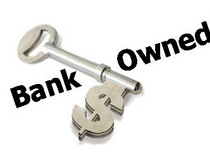
|
| Bank Owned |
In such circumstances, banks could be expected to start holding back. But no, there was too much even cheaper money available for banks to borrow, leverage up with more borrowing, and re-lend to homeowners. It got to the point where a dollar of the bank's own money supported thirty dollars of loans to customers, and homeowners still lined up for more. The solution to the conundrum was suddenly clear: too much cheap money was in circulation, and it was coming from China and the Middle East. Because the prices of houses were going up steadily, banks took a chance on the plain fact that thirty-to-one announces that a loss of house value of 3% means the mortgage is losing money. A couple of other ugly facts are somewhat less obvious: when interest rates go up, the value of the loan goes down. Secondly, when banks reduce their thirty-to-one borrowing to a safer twenty-to-one, the de-leveraging raises interest rates still more, lowering home values still more. A downward spiral can easily get started. Historically, banks were protected by the homeowner's down payment; down payments had become minimal. Adjustable rate mortgages were now popular, a process of shifting the risk of interest fluctuations from the bank to the homeowner, as the homeowner would soon learn if interest rates rose.
 We faced a big problem caused by too much cheap money, and we struggled to save the situation -- by injecting more cheap money.
We faced a big problem caused by too much cheap money, and we struggled to save the situation -- by injecting more cheap money.

|
Time passed, abnormally low-interest rates had persisted after Greenspan's public mutterings. The weak point was the home mortgage, exactly where risky loans are artificially encouraged by implied congressional protection. Reluctant to see foreclosures, politicians stood ready to command mortgages to walk on water. Although it was pretty evident that lending standards were lax, the differing degrees of risk were not reflected in the "risk premium" or width of the "spreads." That is, bond investors remained mysteriously content to be paid interest rates scarcely greater for risky investments than for safe ones such as U.S. Treasury bonds. The markets viewed those two as essentially equivalent. Since these interest rates and the risk evaluation they reflect are set by supply and demand in the credit markets, the persisting anomaly of low rates had to be traceable to either excessive cheap money, or investor overconfidence. In retrospect, it was both. Foreign money flowed in from Far East prosperity and Persian Gulf oil profits. Whether it pushed in or was sucked in, remains a matter of opinion. Wall Street greeted this bonanza with "securitization" -- new lending mechanisms for home mortgages--and builders went into high gear building more houses, especially in California and Florida. They built too many because it's hard to walk away when business is brisk. Because of distorted tax structures, mortgages were the preferred means of borrowing for any private person. Eventually, the bubble burst; it remains to be seen whether we would now go on to some other bubble (commodities, for example) or sink into a protracted depression. If it's to be depression, a new uncertainty arises. When investors accepted low rates in the expectation that politicians would bail out bad mortgages, they surely predicted rightly. The real risk is, it won't do any good.

|
| Alan Greenspan |
As Greenspan was implying, prosperity usually puts upward pressure on interest rates but this time it remained a coiled spring; house prices made unprecedented rises for several years in a row but mortgages remained cheap. In mid-August 2007, bank turmoil in a couple of European banks suddenly prompted a rise in worldwide long term interest rates, more or less obscured by a lurching drop in the stock market. It seems likely this unexpected stock movement created misleading signals; in a day or two stock prices recovered. It was mortgage interest rates snapping back toward normal levels that truly mattered because that predicted excessive home prices would now surely decline; even worse, house plus mortgage might soon cost more than overstretched consumers could afford, provoking panic selling of houses. In any case, house prices could be expected to fall until it was no longer cheaper to rent than to buy, and it was then an open question of whether rents might also be chased down further. Patterns were hard to identify at first; different parts of the country overbuilt to different degrees. Even worse spirals could be imagined, too. If a house must be sold for less than the unpaid mortgage, a homeowner is tempted to surrender the mortgage and walk away, so foreclosures might be more common than economic conditions alone would warrant. If homebuilding stops because of a housing glut, immigrant laborers may -- or may not -- go back home, after first looking around to see if patches of the country are still building houses. A recession may spread, the national election in November may turn our unexpectedly; all sorts of things might -- or might not -- happen.
Banks had been the most strained by all the good fortune of cheap foreign credit because they make their profit on the "yield curve" -- the difference between what they pay for deposits and what they charge for loans. For over a year, the yield curve had been inverted, meaning banks were often close to paying depositors more than they got back from borrowers. Dropping interest rates paid to depositors would increase bank profits, but go too far with that and depositors will be chased away to money market funds, or treasury bills. The problems of banks became the problem of the Federal Reserve. The Fed controls short-term lending costs but generally lets the bond markets establish long term rates. With long rates abnormally low for a long time, banks were severely tested to make a profit, which for them essentially consists of paying depositors low short term rates, and lending debtors the money at high long term rates. A very narrow spread between short and long rates deprived banks of their means of support. This "flattening of the yield curve" became threatening to banks and also to the Federal Reserve, whose whole system of controlling the money supply was based on their control over banks. Subsequent to the crash, a number of commentators led by the Cato Institute have severely criticized the Federal Reserve for maintaining low short-term interest rates for too long, and others have even attributed a motive of supporting the Bush administration by inflating the currency. It is unnecessary to place this construction on the Fed's behavior. If the banks depend for survival on the difference between long and short rates, and if the Fed is powerless to raise long rates, there is nothing to do but lower short rates. This has the unintended effect of stimulating inflation, and Greenspan has later admitted he regrets it. But he seems willing to accept the implication that he was dabbling in politics, rather than admit to what is more likely to have been the cause of this behavior. The whole theory of how the Federal Reserve currently combats inflation is based on "inflation targeting", in which the central bank essentially ignores every other signal and responds to its measurements of inflation in the economy. These measurements were also distorted by the flood of Chinese money, so the very force which was causing inflation was also making it appear that inflation was not a big concern. Since the value of money in current times is almost entirely a decision of the central banks, it seems too central bankers that public trust in that process must be preserved at all costs. And, indeed, when the behavior of Congress is observed on C-span television there can be a reason to be quite sympathetic with the plight of our monetary policy leaders. There remains however little doubt that the formulas for detecting inflation require some modification for changing circumstances.
So to go back a few years to the time when the bubble in housing prices was getting started -- banks had resorted to some new and therefore risky procedures that seemed to side-step their difficult situation. With borrowers flocking in the door, banks were able to sell the loans of constantly rising size to the secondary market as fast as fresh borrowers came in. To understand this inflammatory issue, it is probably necessary to go back to the depression of the 1930s. At another time of confused floundering in the financial markets, public opinion centered on splitting up the functions of big banks for easier control by government regulators. Commercial banks, who obtain their lendable funds by accepting deposits, were forbidden to be incorporated with investment banks, who obtain their lendable funds by selling bonds. And incentives or regulations were modified to direct home mortgages to savings and loan banks. Forty years later, the Arab oil embargo precipitated a monetary situation where interest rates rose to nearly 20%. Savings and loan banks, holding enormous amounts of thirty-year mortgages at roughly 6%, had to close their doors because they could not remain, viable paying depositors, such rates. Thousands of savings and loans, holding nearly 50% of the home mortgages in America, went out of business. A vacuum was thus created, and some other mechanism for financing mortgages was extremely welcome. With almost inhuman ingenuity and innovation, Wall Street invented the CDO and marketed hundreds of billions of dollars worth.
It had elements of a Ponzi scheme but perhaps it was controllable. The banks who merely originated loans did create an undeniable moral hazard because they naturally took less precaution with loans they were immediately going to sell to someone else. No one, it is said, bothers to wash a rental car. Meanwhile, the strain of an inverted yield curve began to take its toll on the banks; after a year of it, their reserves started to get depleted.
Whether banks pushed or were pulled is debatable. Probably the bigger part of the growing problem was created by those ingenious investment banks on Wall Street, who were buying these increasingly risky mortgages and loans by the truckload. Bundling up thousands of mortgages into a new creature called collateralized debt obligations (CDO), they sold them to the public as "securitized debt". In effect, debt was partially converted to equity -- little bonds into big bonds, but the riskiest little bonds sifted out and converted into equity. It was a remarkably imaginative revolution in finance, but even if every step was absolutely perfect there could always be a danger that the generation of many $trillions worth of new paper would topple existing arrangements by simply going too fast for other systems to adjust. That's what happened, although there were inevitably also some design imperfections that got ignored for too long.

|
| housing bubble burst |
So the financial world started to crash in the middle of August 2007, while the rest of us were enjoying a summer vacation. The housing bubble burst; the party was suddenly over. The television was filled with scenes of traders jumping up and down, screaming orders to each other. Commentators commented excitedly every five minutes, and pundits screamed that the Federal Reserve must do something. All of this communications uproar conveyed the impression that a final explosion of some sort had taken place, and we could, therefore, expect a long period of post-bomb silence. But that really was not what seemed to happen. The stock markets dipped but recovered. House prices were down a little, in some places. Gas and oil prices remained too high and went a little higher. The Federal Reserve dropped short-term interest rates a few fractions of a percent, long term rates scarcely moved at all. In the background, America was fighting two overseas wars and a presidential primary campaign, but somehow they weren't part of the equation. Rather, it was explained that the consequences of August would be delayed, taking many months to unwind. A crash, in other words, in slow motion.
That might be so. It often takes months to buy and sell houses; their value may have declined, but a thing is worth what you can sell it for, so you can't be sure what they are worth until houses are actually sold. Essentially the same thing is true of stocks and bonds, and it's hard to know if securities are worth the amount of the comparable most recent sale. or if you should measure them against what you suppose will be the price when you sell later. Auditors and bank regulators are rigid about their answer: banks must "mark to market" if they intend to base future loans on the securities in their vaults. The rest of us would rather wait and see and must do so for tax purposes. You can scarcely blame bankers for hoping the turmoil creates a V-shaped dip that can safely be ignored. Even if it does not, a protracted economic pause can create time to patch things up, generate new sources of income to replace what is lost, if it is lost. Only the gold market seemed to disregard such assurances, gold was emphatically on the rise. After six months of relative calm, it was still possible to believe this was a passing flurry, or to believe we were floating downstream to a tumble over another waterfall. America in the 1930s and Japan in the 1990s had discovered that drift and uncertainty can sometimes last fifteen years. After a brief recital of the events leading up to August, we next embark on a more detailed (but simplified) discussion of what went on, eventually leading to conjectures about what comes next, particularly what the Federal Reserve can and should do about it.
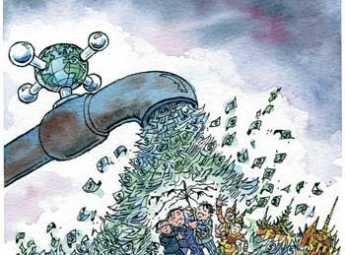
|
| Market Flooding |
Spreads, as bankers say, widen and narrow. Last August, the risk-premium demanded risky lending was stubbornly lower than history suggested was normal. In fact, the prevailing interest rate for mortgages and other long term loans was lower than interest-bearing cash in the form of money market funds was paying, a rather uncommon situation called inverted yield, or an inverted yield curve if you draw a picture of it. Stubbornly low long-term interest rates became a particular concern for the Federal Reserve and the commercial banks it regulates because the spread between long rates and short ones was not only where banks made a profit but how the Fed regulates the money supply. Since now the only way to maintain a profitable differential was for the Federal Reserve to lower short-term rates, it forced the Fed to hurt retirees and be inflationary by flooding the market with cheap short-term reserves. To put it another way, a flood of Chinese or Arab money into long-term bonds could only be kept in balance by a matching American flood into short-term ones. Inflation was already beginning to worry the Fed, so this development was unwelcome. At the extreme, it might force a choice between promoting inflation -- and bankrupting the banks. Add to this the conjecture that old-fashioned banking was eventually destined to vanish anyway, into some bright new computerized efficiency devised by Wall Street wizards; and you have to wonder if the very worst consequence might be to prevent creative destruction from taking place. It's awesome how simple changes multiply into a turmoil you can hardly understand.

|
| Quantitative traders |
On August 17, that risk premium squeeze went away. Long term rates for risky bonds went up, but safe bonds like U.S. Treasuries stayed about the same. While it is always a relief to see things return to normal, the gruesome fact is that money, or at least value, had to be destroyed to accomplish it. The nature of the secondary bond market is that a rise in the interest rate causes a corresponding drop in the price of bonds, a loss which will only be restored by increased interest over a long subsequent period of years, possibly not until the bond reaches maturity. That means for a long time more money is lost on bond principal than is gained on bond interest. An incentive to sell everything else is thus created for the bondholder, creating a contagion of selling. To return to Mr. Greenspan's conundrum, a suppressed interest rate had been creating an illusion of wealth whose disappearance was now reluctantly acknowledged. Some bondholders tried to dump before the full effect was felt, others held back from selling but eventually had to liquidate something to raise working capital. Panic selling spread, and unanimous fear of the unexpected caused "congested" trading, all in a downward direction. The Federal Reserve first helped out by dropping the interbank discount rate (the rate one bank charges another when one of them finds it needs to borrow to keep its books in balance) the next morning, but that action carried further messages of panic. Quantitative traders ("Quants") who programmed their computers to sell on signals of trouble were misled by huge sell activity which actually avoided the long bonds at the root of the problem, primarily because no one would buy them. Astonishing quantities of sell orders of perfectly good securities were accordingly issued by the obedient computing machines. Nobody knew what was going on, but everyone suspected something had been funny about bond rates for two years. Those who did not sell were ready to sell, and would certainly not buy. All markets were congested; credit markets were soon frozen solid. Someone was going to go bankrupt, but there was no time to find out who it was. Without transparency, markets will not clear.
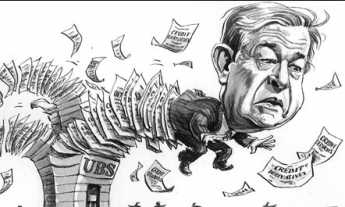
|
| Credit derivatives |
Clarifications eventually surfaced in jumbled sequence. The main difficulty was concentrated in those new mechanisms for financing home mortgages, "derivatives" for which unfamiliar abbreviations leaped into excited jargon. Subprime loans, better called unwise loans were sold to victims, or maybe abused by speculators. "Credit derivatives" based on mortgages and other assets were discussed knowingly by those who a year earlier had never heard of them. The huge size of these mysterious instruments merits emphasis. There had been $26 trillion worth of credit derivatives in existence six months earlier, some said it was now $42 trillion. (A year later it was to be $62 trillion.) Compared with that, the entire mortgage debt of the country was said to be only $9 trillion, and the entire U.S. equity market was something like $13 trillion. Even congressional investigating committees were afraid to say much about something that big, that new, and that obscure.
Most confusing of all was to compare the growing consensus about the underlying difficulty with the solution now demanded by Wall Street, and apparently accepted by the Federal Reserve, our President, and our Congress. We started out with a problem created by foreign money flooding into our mortgage market; that's more or less comprehensible. The Fed then lowered short-term interest rates, Congress produced fiscal stimulus; both of these things created cheaper money, more credit and a lower international value for the dollar. The centerpiece of the solution was to create still more cheap credit, both at the Federal Reserve and with a Congressional Stimulus Package, when the problem was we already had too much cheap money.
Please, sirs. Would you mind saying that again, slowly?
Brunnemeier's Explanations for the 2007 Crash
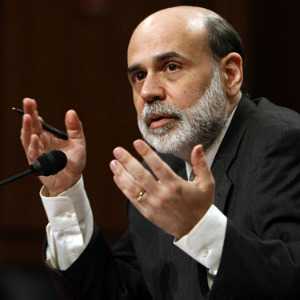
|
| Ben Bernanke |
The Chairman of the Federal Reserve from 2005-2014, Ben Bernanke, spent much of his time explaining current economic tangles to committees of Congress. At a hearing, his suffering audience asked for some homework. "Please suggest a few articles you think we should be reading." Two of his four resulting suggestions were written by Markus K. Brunnermeier, Professor of Economics at Princeton. Some of what Brunnermeier said was already known, some of it was novel. Of greater significance was that Bernanke, a scholar of economic collapses, and then vested with the power to investigate just about any lead, would make a public endorsement of Brunnermeier's analysis to Congressmen who actually held the power to implement laws. They weren't talking to an audience of helpless college students. Congressmen knew less about the minutia of the topic, but they had the power to act on their beliefs.
No doubt, further investigation will uncover more kinks in the hose, and subtleties will prove particularly arcane, or particularly blameworthy. Nevertheless, we seem to have probably reached the point to assume the main features of the catastrophe were on the table, articulated to people not easily deceived. Moreover, Congressmen had already adopted one 2000 page law that almost none of them had read; this must not be permitted to keep happening. So among other things, let's hope they have at least learned to be careful. If Brunnermeier and Bernanke have given us a list, let's expose it to public discussion. What's usually important is what they do, not what motives they claim.

|
| Markus K. Brunnermeiere |
1. Following the dot-com collapse in 2001, the Federal Reserve held interest rates abnormally low, claiming fear of even more severe deflation from the bubble bursting uncontrolled. By this description, the housing bubble was really the second dip of a double bubble. Within endless successions of bubbles, a futile issue is which tooth of the buzz saw cut off your finger. What determines your conclusion is the point where you chose to start. In this case, the preceding seventeen year period of "Great Calming" may perhaps make routine stress-test analysis possible. For contrary example, was a seventeen year quiet period without a major recession actually a coiled spring? If you can guard against such exceptions, perhaps correct conclusions may be reached.
2. The emergence of the developing world, especially China, from extreme poverty into relative affluence generated huge wealth surpluses which no economy was ready to absorb without danger of inflation. There is a feeling that China should have allowed its currency to rise. However, the same was said of Japan two decades earlier, and in any event, we may not have had the power to change it.
 In summary, then, the emerging problem was one of too much cheap credit. Because of related uncertainties, this was a storm we probably could not prevent. 
|
3. For decades, America has sought the goal of universal home ownership. Borrowing to buy a home has been encouraged by tax-favored mortgages, loosened credit, and bankruptcy standards, and weak borrowers have been supported by government guarantees in the form of FHA, Fannie Mae, Ginny Mae, and Freddie Mac. The Savings and Loan crisis can be viewed as another variation on the theme of wider home ownership. Meanwhile, renting has been discouraged by low returns for the landlord, with the additional hazard of reducing the mobility of the workforce, particularly in a recession.
4. Home mortgages have traditionally been issued by local lenders. However, cheap credit was primarily available from China, so new conduits needed to be constructed. The process of securitization of mortgages through aggregation and packaging as marketable bonds was a swift and effective way to put the cheap Chinese credit to work, serving the acknowledged national desire to promote home ownership.
 In a second summary, cheap credit from the Orient pushed us toward some sort of bubble. Our own encouragement of home ownership assured the bubble would be a housing bubble. Perhaps some other form of a bubble would be preferable; if that is the case, our government is at fault. 
|
The first four bullets in this analysis constitute conventional argument why we had the collapse of a housing bubble in August 2007, and this collapse in some way is supposed to have led to a recession. In his recent memoir, Tony Blair of England reduced the argument to a politician's catchy phrase. "We didn't have a market failure, we had a failure of one sub-segment of one portion of the market." But that is not exactly true. In August 2007 the markets experienced a sudden liquidity crisis, a lack of ready cash to pay immediate bills. A sudden worldwide shortage of cash caused a halt to the trading of just about everything. People could not collect their bills so they could not pay their bills. Survival in this environment depended less on how wealthy you were than on how much loose unemployed cash you happened to have when the music suddenly stopped. Possibly because of the real estate bubble, and possibly for other reasons, the whole world was in a trading frenzy, and cash was king. At this point, Brunnermeier is surely right that the comparatively small amount of real estate defaults was tiny in comparison with the trillions of dollars lost in the crash. He searches for "amplifiers". The possibility exists however that panic and hysteria resulted in bizarre losses, simply because everything uses money, so a shortage of money paralyzes everything. Consider the following issues:
5. It is said that 70% of stock market trades are now conducted between two unattended computers. The finest mathematicians in the world are probably programming those computers, but transaction speeds are now measured in nanoseconds. There is no time to evaluate events; it is inconceivable that every event has been anticipated. Imposing sudden pauses in trading, even for five or fifteen minutes, has proven to be remarkably effective in combating false rumors. However, the shift in trading from deposit banks to investment banks has created a whole host of unexpected advantages for the first trader who ducks out of the market. A traditional "run on the bank" is essentially based on first-mover advantage. But when short-term loans must be turned over in a day or two, simply pulling out for a day amounts to a run on the bank of a slightly different sort. It's the exploitation of the first-mover advantage in commercial credit, money market funds, repo's, daily auctions and many other nooks and crannies. A liquidity crunch makes many people into first-movers who didn't intend to be one.
6. Globalization has tended to externalize transactions within an international corporation into many sales steps between suppliers and assemblers all over the world. While this transformation has been accomplished with remarkable ease, it still vastly increases the volume of short-term loans, subject to the new form of a bank run, by hesitation whenever liquidity dries up.
 Boom times and inexperience with new techniques created unsuspected instabilities. Major examples are found in computerization, globalization, derivatives, and -- curiously -- diversification. 
|
7. For fifty years, diversification has been regarded as a safeguard, particularly when the various components are in independent environments. A liquidity crunch wipes out the advantages of diversification, however, because every sale involves money. Just as important is the hidden risk that failure in one area may drag down another. The most drastic example in the recent crisis was in the "Monoline" insurers, who insured only municipal bonds until recently when they diversified into insuring mortgage-backed securities. And of course, when subprime mortgages collapsed, they took down municipal bonds, with many more ripple effects after that. Diversification improves safety, but only if the entities which fail are inconsequential to the whole portfolio. Innovative bundling and tranching of securities can create hidden aggregates with the power to spread contagion if they injure the credit rating, or bond rating, or reputation rating of a company. Advanced mathematics could probably establish guidelines for the danger points, but then other advanced mathematics will find ways to evade the analysis.
8. Credit default swaps are merely short-term insurance policies against definable risks, and they have greatly increased the willingness of international commerce to take risks they would otherwise avoid. However, they are also hidden over-the-counter transactions; when they grew in a couple of years to be several times the size of the entire stock exchange, they frightened the regulators. When the crunch came, regulators were not reassured to be told that most of these swaps were in opposing directions, which would surely "net out" to a comfortable equilibrium. As matters turned out, credit default swaps did not apparently cause many financial failures. But when it was learned that it would take nearly three years to untangle all the paper at AIG, it was highly unsettling. Innovators and mathematical quantitative traders will always outwit regulators because they have a far greater incentive to get ahead of the curve. But more midnight accusation sessions at the time of a crash simply cannot be tolerated. If clearing credit default swaps through an exchange does not improve transparency, something else must be suggested and tried. The issue here is the huge volume of transactions. It should not be impossible to devise volume standards, above which all future innovations must develop transparency mechanisms.
 In the fourth summary, the default of subprime mortgages was fairly serious, perhaps amounting to two or three hundred billion dollars. However, the liquidity crunch was much more serious, requiring $850 billion just to get the markets open, and leading to stock market losses in the trillions. More research is needed to decide how much of the difference is explainable by the existence of amplification mechanisms, as Brunnermeier believes, or whether a more substantial explanation for the recession lies in world-wide leveraging and deleveraging. The size of the mortgage defaults was clearly not large enough to explain the crash, but it may have been large enough to destabilize key elements of the system into a domino effect of some sort. The distinction is somewhat semantic, with its main value in moderating political opinion about the issue of "too big to fail". That is, the general public perception of the role of huge economic forces, as opposed to blunders by a few key firms.{ILQ-End} 
|
9. The liquidity crisis of the summer of 2007 was a brief, almost total, lock-up. This is not to imply that worldwide cash shortages had necessarily been building up for months until the system crumpled; simple miscommunication could explain a brief lock-up just as well. But there can be little doubt that chaos convinced major decision-makers they would be wise to conserve their own cash more carefully. The instantaneous main conclusion was that certain interest rates had been too low, and would soon go up. A rise in interest rates forces a decline in the value of the loan, the bond, or the guarantee. If interest rates double, the principle will be worth only half as much for the duration of the loan; even refusing to sell the asset leads to an opportunity loss throughout the duration to maturity. For a while, there was uncertainty just how many roles the subprime mortgages were playing, but it scarcely mattered. Alan Greenspan had famously remarked that low long-term interest rates were a "conundrum". If they went back up to conventional levels, it would not so much matter that foreclosures would rise from 5% to 10% or even 20%. What would matter was that the 80-95% of un-foreclosed mortgages would become 5% bonds in a 10% bond environment, and hence destroy many times as much wealth. Since that cat was out of the bag, it might be a long time before it got stuffed back. Looking back for causes, it was suddenly clear that we had created a situation where everyone was terrified interest rates would become normal. If they became normal suddenly, bankruptcies would be wide-spread. If they went back slowly, fearful paralysis might last a long time. The Federal Reserve had already lowered short-term rates to nearly zero, so their efforts to ease the pressure on deposit institutions led to the purchase of long-term bonds. It was not reassuring to see that if long rates went up later, the lender of last resort would then likewise be in the position of losing money.
10. At a time when commercial liquidity was weak, the public started to draw down its cash reserves. The protracted experience of low short-term rates was particularly hard on unemployed people, especially retirees, who tend to live on the interest on money market funds and CDs because of a concern for the safety of principal. When ready cash is depleted, such people invade their long term securities; when times are precarious, even the affluent ones decline to invest and limit discretionary consumption. The nation thus begins to use up its cash reserves, and the consumer goods segment of the economy starts to weaken. In a primitive country, this sort of response soon leads to famine; in more affluent America, it is less obvious that cars are getting older, clothes are getting worn out. Meanwhile, businesses are declining to expand or to hire, and cash reserves are possibly even expanding, waiting for a more suitable time to invest. If the subprime mortgages and similar toxic debts can be cleaned up before the nation really exhausts its hidden cash reserves, the recession will pass. If cash reserves ever do get depleted beyond a tipping point, industrial growth will slow, and a twenty-year recession such as the Japanese are suffering, cannot be completely dismissed.
Selling Entire Towns

|
| Jason Duckworth |
Recently, Jason Duckworth of Arcadia Land Company entertained the Right Angle Club with a description of his business. Most people who build a house engage an architect and builder, never giving a thought to who might have designed the streets, laid the sewers, strung out the power and telephone lines, arranged the zoning and otherwise designed the town their house is in. But evidently it is a very common practice for a different sort of builder to do that sort of wholesale infrastructure work -- privatizing municipal government, so to speak. A great deal of what such a wholesale builder does involves wrestling with existing local government in one way or another, getting permits and all that. In a sense, the existing power structure is giving away some of its authority and does so very cautiously. Sometimes that involves suing somebody or getting sued by somebody. Perhaps even greater braking-power on unwelcome change is that the wholesale builder is in debt until the last few plots are sold, and realizes his profit on stragglers. Since it often happens that the last few plots are the least desirable ones, this is a risky business. Big risks must be balanced by big profit potential, and one of the risks of this sort of privatization is that too much consideration may be given to the players at the front end, the farmer who sells the land and the builder who must keep costs down, at the expense of the long-range interests of the people who eventually live in the new town. Top-down decision making is much more efficient, but its price is decreased responsiveness to citizen preferences.

|
| For Sale |
As it happens, Arcadia specializes in towns designed to look like those built in the late 19th Century. Close together, a front door near the sidewalks, front porches for summer evenings. To enhance the feeling of being in an older village, Arcadia specifies certain rules for the architecture, to make it seem like Narberth or, well, Haddonfield. Until recently, suburban design emphasized larger plots of land, and few sidewalks, with streets often ending in cul-de-sacs instead of perpendicular cross-streets in the form of squares. The "new urbanism" appealed to those who were seeking greater privacy, revolving around the idea that if you wanted anything you drove your car to get it. Three-car garages were common, groceries came from distant shopping centers. There are still plenty of new towns built like that today, but Arcadia appeals to those who want to be close to their neighbors, want to meet them at the local small stores scattered among the houses. In the 19th Century, this sort of town design was oriented around a factory or market-place; since now there are seldom factories to orient around, the appeal is to two-income families who want to live in an environment of similar-minded contemporaries. The whole community is much more pedestrian-oriented, much less attached to multiple automobiles.
Since Mr. Duckworth mentioned Haddonfield, where I live, I have to comment that the success of living in a town with older houses depends a great deal on the existence of a willing, capable yeomanry. Older houses, constantly at risk of needing emergency maintenance, need available plumbers, roofers, carpenters, and handy-men of all sorts. Because it is hard to tell a good one from a bad one until too late, this yeomanry has to be linked together invisibly in a network of pride in the quality of each other's work and willingness to refer customers within a network that sustains that pride. A tradesman who is a newcomer to the community has to prove himself, first to his customers, and almost more importantly to his fellow tradesmen. If you happen to pick a bad one, good workmen in other trades are apt to seem mysteriously reluctant to deal with you as a customer, because you too are somewhat on trial. Maybe you don't pay your bills, or maybe you are picky and quarrelsome. In this way, the whole community is linked together in a hidden community of trust. Over time, the whole town develops certain recognizable social characteristics that a brand-new town doesn't yet need. If that time arrives without a network of reliable tradesmen, the town soon deteriorates, house prices fall, people move away.
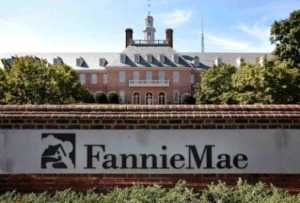
|
| Fannie Mae |
It's curious that the residents of such a town are a breed apart from the merchants in the nearby merchant strip. If the merchants of town life in that same town, there is much less conflict. More commonly, however, the merchants rent their commercial space and commute from distant places. That disenfranchises them from voting on school taxes and local ordinances and creates a merchantile mentality as contrasted with a resident community, dominated by high school students. One group wants lower taxes, the other group wants to get their kids into Harvard. One group wants space for customer parking, the other group is opposed to asphalt lots. And in particular, the residents want to avoid garish storefronts and abandoned strip malls. Since the only group which has an influence on both sides of this friction are the local real estate agents and landlords, their behavior is critical to the image of the town. When real estate interests are not residents of the town it is ominous, and they are well advised to remember that the sellers of houses are the ones who choose a real estate agent for a house turn-over. There's more to this dynamic than just that, but it's a good place to begin your analysis. Suburban real estate interests are constantly tempted to get into local politics, but politicians are the umpires in this game, and it soon becomes bad for their business if real estate agents potentially put their thumb on the scales.

|
| FHA Seal |
All politics is local, but all real estate is not entirely local. The present intrusion of the Federal Government into what is normally a purely local issue has become more pointed in the present real estate recession. Almost all mortgages are packaged and sensitized by "Fannie Mae and Freddy Mac". By overpaying for the mortgages they package, these two federal agencies are subsidizing the banks they buy the mortgages from. Or, that is half of the subsidy. The other half is the Federal Reserve, which presently lends money to banks at essentially zero interest. Acquiring free money from the "Fed", while selling mortgages to Fannie Mae at above-market rates, the federal government supports the banks at both ends. And that's not quite all; there is something called the FHA, Federal Housing Authority, which guarantees mortgages. Essentially an insurance policy, the FHA guarantee is issued for a cost to home buyers who meet standards set by Congress (for which, read Barney Frank and Chris Dodd). Although houses during the boom were selling for 18 times the estimated rental value, they are now selling for 15 times rental. FHA will insure such risks, but the banks won't lend more than the normal proportion, which is 12 times rental. Consequently, almost all mortgages are FHA insured, while the federal administration storms with a fury that the banks "won't lend". And indeed it begins to look as though banks will never issue uninsured mortgages until home prices fall another 25%. If home real estate prices do decline to a normal 12 times rental, a lot of people (i.e. voters) will be unhappy, and not just homeowners who bought at higher prices. The market is fairly screaming that you should sell your house and rent, but so far at least, these federal subsidies seem to be holding prices up. When normal pricing arrives, the recession is just about over, but it certainly won't feel that way if you are a seller.
Power of the Purse
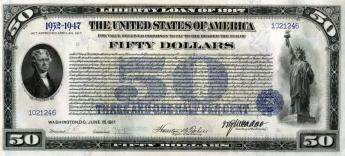
|
| Liberty Bond |
In 1917, Congress passed a law, quite possibly not understanding its full implications. From the founding of the republic until that time, Congress had approved the exact amount of each bond issue as enacted, neither more nor less. With the First Liberty Bond Act of 1917, however, Congress began to allow the administration to issue bonds as it pleased, up to some specified debt limit. Periodically since that time, as the amount in circulation approaches the debt limit, Congress raises the limit. No doubt this procedural change seemed like legislative streamlining, making it unnecessary for Congress to interrupt other activities to respond to a debt level which creeps up on its own time schedule. The overall effect of this change was significantly different, however, and probably unintentionally.
If the authorized debt limit is raised by large enough steps, it effectively amounts to Congress turning over debt decisions to the executive branch. Conversely, raising the limit only a small amount soon triggers a repeat request, which by routine becomes so inconsequential that Congress stops paying attention to it. Regardless of the size of the block grant, bulk authorization of blocks of debt results in the power of debt creation shifting toward the President. That was not what the Constitutional Convention intended.

|
| Founding Fathers |
The Founding Fathers remembered taxation as one of the main issues of the revolt from England. Whether by King or President they had no intention of permitting the Executive to tax as he pleased; the issue traced back to the Magna Charta. Nor would they permit unlimited federal borrowing to generate escape hatches which would soon enough transform into higher taxes. Taxes, therefore, must originate in the House of Representatives, and bond issues were approved one by one. Following the 1917 liberalization, it required only fifty years before unrestrained bond limits reached a point where future national debt obligations loomed beyond the easy ability to pay them off. If they were ever pronounced unpayable by the international bond market, interest rates would rise, and eventually, federal bonds would become unsalable. With Greece, Portugal, and Ireland already flirting with bankruptcy, the approaching danger seems quite understandable to the voting public.

|
| Constitutional Convention |
The issue is constrained by another barrier. The Fourteenth Amendment to the Constitution, Section Four, forbids dishonoring "the validity of the public debt of the United States, authorized by law." Enacted after the Civil War, this Amendment was intended to prevent future states or congresses from reversing the Reconstruction Acts, but it has the additional effect of preventing future Congresses from dishonoring interest and debt repayments on existing debt. The present Congress, therefore, retains the latitude to prohibit the issuance of additional debt but is forbidden from dishonoring existing debt.
This seems like a good principle to re-emphasize, entirely disregarding the merits of the TARP, the Dodd/Frank Act, or Obamacare. Indeed, restating the Constitutional intent for Congress to be chiefly responsible for taxes and debts, seems like a very good thing to do, quite regardless of whether present national debt limits ought to be raised. The 1917 Act was a mistake, probably an unconstitutional one, and should be reversed. Holding conferences in the White House about whether to issue debt raises uncertainty about whose duty it is. The responsibility belongs to the House of Representatives, and should stay there.
Helping the home owner

|
| FDIC LOGO |
The Treasury's lender/investor support programs may have stopped October's (2008) bank-run and foreclosure panic. But it is generally agreed the crisis would not bottom and turn around until a way is found to slow the fall in house prices, the root cause of the housing crisis.
Both the City of Boston and the FDIC (at IndyMac, which they now run) are trying to address the mortgage uproar at its source: the homeowner, in trouble after paying too much for a house. Cheap mortgages tempted him to overpay, so still deeper causes trace back to Far Eastern prosperity, supported by a Chinese currency pegged too low in order to stimulate exports. These grander visions will probably be topic of the November 15 monetary summit.
Meanwhile, Boston has dozens of blocks of foreclosed houses. That city is attacking its local problem from two directions: (1) matching up 1st-time home buyers with homeowners in distress and (2) working with mortgage servicers to adjust troubled mortgages. In both cases, the objective is to keep the houses occupied and out of foreclosure. But if new home buyers again pay too much for the house, the problem is not entirely solved.
Remember, there are three elements to a mortgage: principal, interest rate and term.
Adjusting the principal is currently off the table but efforts are being made to fix and lower the interest rate and lengthen the term so resulting payments do not exceed 38% of gross monthly income. Sometimes this can't be done and the homeowner loses the home. But it helps quite a number of people.
Interest modification is resulting in mortgage terms of 40 or 50 years. That sounds almost like indentured servitude but at least such grass-roots efforts are starting to provide some relief for those who were swept into the housing bubble.
(It's interesting that one unintended consequence of securitization is that the counterparty to these negotiations is the mortgage servicer, not the original lender or the current holder. The effect of this is to reduce the natural resistance of a bank to lend more than it thinks the house is currently worth. Original lenders are a new mix of people; they sold the mortgage on to the current holders, who are a widely diffuse group of investors, both institutional and retail, who in most cases also cannot easily be identified. An exception is that in several cases where attempts were made to adjust the principal instead of the interest or the term, class-action lawsuits were initiated by several hedge-fund investors. That mainly explains why adjustments to interest rate and term are the current focus rather than principal. For obvious reasons, stock market short-sales seldom evoke the same response, at least from hedge funds.)
Mr. Obama Attacks Unemployment

|
| Barack Obama |
Ever since two months after his inauguration, Barack Obama has been declaring that the central issue of the re-election campaign of November 2012 will be unemployment, now running at 9.2% of the workforce, and higher among members of his race. To hear it chanted, the issue is Jobs, Jobs, Jobs. His opponents, particularly the Tea Party element of the Republican Party, reply that he is going to remake the issue as Inflation, Inflation, Inflation. The present depression is remarkably similar to the one in the 1930s, except possibly for its unknowable outcome.

|
| Maynard Keynes |
Both Presidents Hoover and G.W. Bush were caught by surprise by a stock market crash, and both Franklin Roosevelt and Barach Obama were unprepared for it. It has been said that Roosevelt attempted the scheme of Maynard Keynes, while the Republicans in 1932 wanted to balance the budget. A little of that is still uncertain, but it's pretty clear that Obama is now attempting the Keynes remedy, while the Republicans seem to be saying we should balance the budget. But a more accurate description of what is privately promoted is that Obama wants to take money from the public sector and have the private sector pay it back after we recover from the depression. The Tea Party wants to take money from the public sector and pay it back after a private sector recovery. Same thing. Forget about token taxes on the "rich" and diversionary bluster about balancing the budget. They both want to shift money from the public sector to the private one, and they both plan to pay it back later when we can afford to. Or else never pay it back, letting one sector or the other dwindle. But the problem with this proposal from either party is that recovery is likely to take longer to arrive than the next election. Like Franklin Roosevelt, Obama will try to make it appear the recovery has arrived, first. That illusion worked well enough in 1936 for Roosevelt to be reelected in a landslide, but as soon as pump-priming relaxed, the double-dip of 1937 rebounded, adding to the political fury of the Supreme Court-packing issue. Five years of artificial stimulating wasn't long enough in 1937, and very likely won't be long enough in 2012. If Obama can't get past the five-year mark, the Democrats are probably done for, because the public won't stand for a five-year repeat of something that didn't work. The possibility of a third party, or a major two-party rearrangement, would be a real one.
What about balancing the budget -- will that work? No one knows, but it seems likely the public would be in a mood to try the one proposal that hasn't been attempted. It's not impossible that a deflation this severe will always take longer than five years to cleanse itself, so nothing at all will work until, in Andy Mellon's words, the evil has been wrung out of the system. At least we might then start telling ourselves that a catastrophe which ruins a whole generation is too hideous a price to pay for a housing spree. Ever again.
National Debt, Presidential Hat Tricks, Shale Gas and Argentina

|
| Alexander Hamilton |
This-here speaker at the Right Angle Club began a discussion of the "Fiscal Cliff" razzle-dazzle of 2012, by changing his mind about the causes of the financial crash of 2007. Originally, it seemed as though globalizing 500 million Chinese out of poverty had destabilized the exuberant American mortgage market by flooding it with cheap credit. Supplanting that idea, or perhaps only supplementing it, must now be added the overextension of national debt itself to a point of bringing national borrowing to a halt.
Early in the Eighteenth century the Dutch and English had monetized national assets through a system of national borrowing formalized by Necker in Europe, and Robert Morris and Alexander Hamilton in America. Aside from a handful, no one could understand what they were talking about. Try reading that sentence a second time.
It amounted to guaranteeing all the private credit in the banking, investment, and commerce systems, with a national debt (in the form of Treasury bonds) which monetized all the assets of the whole nation. That action more or less doubled their value, just as any bank loan is seemingly owned by two people at the same time. Carried to an extreme, it might imply that America could turn Guam and Hawaii over to China if we defaulted on our debt. That was never actually intended to happen, and it never has, because all nations now fear the deflation which could result from triggering a massive exchange of national assets. The nebulous issue of "National Sovereignty" interferes with territorial transfers by any means other than war. If one nation defaults against a second nation which is afraid to go to war, it is just the stronger nation's hard luck about the debts it has chosen to support unless a transfer of assets actually happens. The Treaty of Versailles did transfer assets to the victors, and set off World War II, although it is considered bad manners to mention it. That's a simplified view of our international financial system, which admittedly skirts uncertainty about how much national debt is too much.
In fact, no one knows how much is too much until everyone runs for the exits. Now that politicians have control of computers and "big data", a modern description places the blame on Alan Greenspan the former Chairman of the Federal Reserve. For eighteen years Greenspan produced delicious world prosperity by steadily increasing American national debt faster than the American economy was growing. Sooner or later this approach was going to uncover how much was currently too much Federal debt. With silver and gold removed from the equation, one could see that default would certainly loom whenever the size of the debt became so large it could never be serviced by the Gross Domestic Product (GDP), and possibly sooner than that, if enough people could guess what was coming. This reality might be obscured temporarily by reducing interest rates, modifying international trade balances, and inflation. When the stars were in alignment however, the system just had to collapse and start over. Because it happened gradually, perhaps it would unwind gradually. In 2007 what happened was that everybody tried to get out the door at the same time. Essentially, our two political parties made opposite assessments: the party of Hamilton -- Republicans -- announced this system was doomed, while Democrats --the party of Andrew Jackson -- announced they could stave off disaster by making the rich Republicans pay for it. Both parties were partly right but essentially wrong, and the Democrats hired a better magician.

|
| Henry Clay |
It will take months or even years to be certain just what strategy was pursued. It would appear the Democrats chose to repeat the performance of the Obamacare legislation, eliminating national debate by eliminating the Congressional committee system of examining details in advance of a vote. Given one day to digest two thousand pages prepared by the Executive branch, no time was allowed for public opinion to form about Obamacare. In the case of the fiscal cliff episode, Congress was given less than one day to consider 150 pages allegedly prepared the day prior to the vote. Some will admire the skill of the executive branch in orchestrating this secret maneuver, but eventually, it must become apparent that policy decisions have been transferred from the legislative to the executive branch of government. Perhaps the Congressional Republicans are as stupid as the Democrats portray them to be, but it is also possible that a decision has been made to tempt the Democratic leaders into repeating this performance several times until eventually, the public is ready to consider impeachment for it. No matter what the strategy, we are now threatened with imagining some moment when gun barrels come level and live rounds slide home. We may pass up the opportunity to criticize Henry Clay for concentrating undue power in the Speaker of the House, or to uncover the way Harry Reid was persuaded to surrender Senate power to the Executive; both miscalculations are fast becoming irrelevant in the flurry of events. We came close to borrowing too much, exceeding our means to pay it back, that's all. A New York Times editorial economist feels we can "grow" our way out of this flirtation with danger, and we all certainly hope so.
Seemingly, there are only two ways to cope with over-borrowing, once we step over the invisible line. A nation may cheat its citizens with inflation, or it may cheat foreign citizens by defaulting on their currency. We are indebted to Rogoff and Reinhart for pointing out there is no difference between inflation and default except the identity of the cheated creditor; so most politicians prefer to cheat foreigners. Either way, cheating makes deadly enemies. Two centuries ago, Alexander Hamilton suggested a third way out of the problem, which we would today call "growth". But here, cheating is pretty easy: If the limit is some ratio of debt to GDP, find a way to increase nominal GDP.
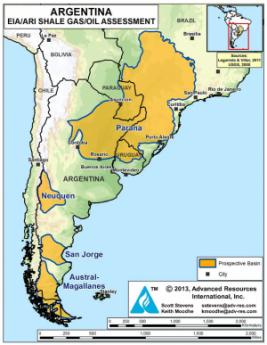
|
| Shale Gas and Argentina |
The most astonishing current example of the power of "growth", is shale gas. It may not be totally clean, but it is cleaner than oil or coal, and far cheaper. We suddenly have so much of it the price of energy is artificially lowered, and we talk, not merely of energy independence, but of restoring the balance of international payments by exporting it. Germany is constructing steel mills to utilize iron ingots made in America with gas instead of coal. Pittsburgh was once the center of steel production because that's where the coal was, the most expensive ingredient to transport. Suddenly it is now apparently cheaper to transport the energy source to wherever you find limestone and iron ore. JP Morgan got rich the other way, transporting limestone and iron ore to Pittsburgh, where the coal was. Russia now finds it has lost its leverage over Eastern Europe's energy supply, and the Arabs (?Iranians?) will no longer have a monopoly to provide the wealth supporting Middle-Eastern mischief. China may lose interest in Africa. And in America we may develop the courage to rid ourselves of the corn subsidies for gasoline; cutting the wind and sunlight fumbles also emerge as obvious ways to cut the deficit. That's what we mean by growth. It's so powerful it makes action by any American President seem trivial by comparison.
Presumably, President Obama does not welcome being upstaged by an economic force he doggedly resisted. He may seek ways to imply it was his idea all along. When that happens, rest assured that everyone else is then a fracker. But there is another alternative Presidential path, which in extreme form is emerging in Argentina without much media attention. In short, Argentina discovered signs of oil deposits but was unable to exploit them. A European oil company was enticed to develop the oil reserves at its own expense, and effectively did so in expectation of reward from the resulting oil sales. Suddenly, the Kirchner government expropriated the oil company, paying for it with Argentine bonds. The ink was scarcely dry before the Argentine government abruptly turned around and offered to buy back the bonds for 24 cents on the dollar. And unless someone is willing to send gunboats, the previous owners of the oil company are just out of luck. Appeals to the UN are futile; because on the one-nation, one-vote principle, there are more expropriator votes in the UN than potential victims. The only thing visible which could save capitalism in South America from the revolution in shale gas competition. Presumably, Argentina has lots of shale gas, but who will lend them the money to frack it?
25 Blogs
August, 2007: Sudden Financial Jolt
 Calmer heads may have seen financial problems building for a decade. The rest of us only noticed a volcano eruption.
Calmer heads may have seen financial problems building for a decade. The rest of us only noticed a volcano eruption.
What's a Collateralized Debt Obligation (CDO)?
 SDO's are a way to reduce the cost of debt by reducing the cost of assembling the cash. More questionably, they can reduce the cost of evaluating the credit worthiness of the debtor.
SDO's are a way to reduce the cost of debt by reducing the cost of assembling the cash. More questionably, they can reduce the cost of evaluating the credit worthiness of the debtor.
Securitization
 Taking mortgages away from banks is a promising financial innovation. Unfortunately, it is part of a much longer process of pushing banks out of the banking business, which will remain a very dangerous process until it is complete.
Taking mortgages away from banks is a promising financial innovation. Unfortunately, it is part of a much longer process of pushing banks out of the banking business, which will remain a very dangerous process until it is complete.
The Housing Bubble
 For now, let's call the economic upheavals of 2007 a housing bubble. It followed a dot-com crash, and both bubbles were part of the electronic revolution, beginning in 1975.
For now, let's call the economic upheavals of 2007 a housing bubble. It followed a dot-com crash, and both bubbles were part of the electronic revolution, beginning in 1975.
Frozen Markets
 After August 17, 2007, it was widely reported that financial markets froze up. What in the world does that mean?
After August 17, 2007, it was widely reported that financial markets froze up. What in the world does that mean?
What's a Derivative?
 Forget about math textbooks. Derivatives are a way of making or losing the money you dare to risk, without tying up a lot of non-working cash in the meantime.
Forget about math textbooks. Derivatives are a way of making or losing the money you dare to risk, without tying up a lot of non-working cash in the meantime.
What is an NRSRO?
 For a significant time, the only thing most people knew about credit derivatives was that some were rated AAA, so they must be safe.
For a significant time, the only thing most people knew about credit derivatives was that some were rated AAA, so they must be safe.
Debt Rating Agencies
 Gigantic volumes of innovative debt instruments forced investors to rely on the opinion of rating agencies for what should be a core bank function: know your counterparty.
Gigantic volumes of innovative debt instruments forced investors to rely on the opinion of rating agencies for what should be a core bank function: know your counterparty.
What's a Mezzanine Loan?
 Be careful of mezzanines, especially in the financial world.
Be careful of mezzanines, especially in the financial world.
Inverted Yield Curve: The Depositors' Viewpoint
 Much has been made of risks for giant creditors in the 2007 credit crunch. What about the little creditors, the depositors with their savings at stake?
Much has been made of risks for giant creditors in the 2007 credit crunch. What about the little creditors, the depositors with their savings at stake?
Murky Crisis
 Six months after the credit crisis began, it's still not clear how bad it is.
Six months after the credit crisis began, it's still not clear how bad it is.
Sovereign Wealth Funds
 If sovereign debt is a headache, just contemplate sovereign-wealth funds.
If sovereign debt is a headache, just contemplate sovereign-wealth funds.
Credit Crunch Turning Point, at Eight Months?
 After eight months of American housing mess, we are about to see if things will now finally go right, or turn into an international monetary crisis.
After eight months of American housing mess, we are about to see if things will now finally go right, or turn into an international monetary crisis.
Job Loss Map
See the growth in jobs in the US go to losses.
Financial Meltdown Documentary
PBS Frontline documentary about the financial meltdown during the terrifying days in September 2008
Philadelphia City Controller
 A City Controller is expected to criticize the city's administration. Alan Butkovitz does his duty.
A City Controller is expected to criticize the city's administration. Alan Butkovitz does his duty.
Oriental Money
 The Chinese did not invent the export-driven economy, or monopolize its use. But their command structure allowed them to exploit it most effectively.
The Chinese did not invent the export-driven economy, or monopolize its use. But their command structure allowed them to exploit it most effectively.
iPhone, Skype, Land Lines and International rates
 The iPhone is the bomb and with Skype it is really the most functional cell phone around. Don't leave home without it.
The iPhone is the bomb and with Skype it is really the most functional cell phone around. Don't leave home without it.
Banking
 .
.
Brunnemeier's Explanations for the 2007 Crash
 By common agreement among scholars, Markus K. Brunnermeier has come pretty close to a complete description of the causes of the 2007 economic crash.
By common agreement among scholars, Markus K. Brunnermeier has come pretty close to a complete description of the causes of the 2007 economic crash.
Selling Entire Towns
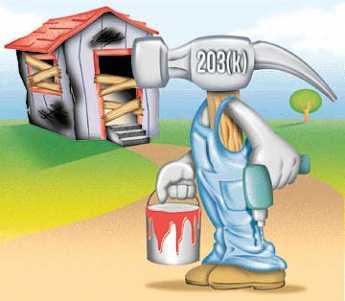 Some builders build whole towns without houses and then sell them to custom home builders.
Some builders build whole towns without houses and then sell them to custom home builders.
Power of the Purse
 Establishing and revising a national debt limit was a mistake in 1917. Its mistakenness becomes progressively more evident as national debt approaches the point where we could not possibly pay it off, and several foreign countries demonstrate what can then happen.
Establishing and revising a national debt limit was a mistake in 1917. Its mistakenness becomes progressively more evident as national debt approaches the point where we could not possibly pay it off, and several foreign countries demonstrate what can then happen.
Helping the home owner
 The Treasury's support may have stopped the bank-run panic but the mortgage crisis will not bottom out until house prices stop falling, the root cause of the crisis. Unfortunately, house prices are still no bargain.
The Treasury's support may have stopped the bank-run panic but the mortgage crisis will not bottom out until house prices stop falling, the root cause of the crisis. Unfortunately, house prices are still no bargain.
Mr. Obama Attacks Unemployment
 The 2012 election campaign has not yet selected its Republican candidate, but Mr. Obama has been officially running for re-election for several months. His big issue is unemployment, and he has staged a dramatic moment for three days after Labor Day, 2011. Sixteen more months of campaigning await us.
The 2012 election campaign has not yet selected its Republican candidate, but Mr. Obama has been officially running for re-election for several months. His big issue is unemployment, and he has staged a dramatic moment for three days after Labor Day, 2011. Sixteen more months of campaigning await us.
National Debt, Presidential Hat Tricks, Shale Gas and Argentina
 The Franklin Inn Club discusses Obama's maneuvers in the context of what might have been a better approach.
The Franklin Inn Club discusses Obama's maneuvers in the context of what might have been a better approach.